Restaurant Financial Management
VerifiedAdded on 2020/02/14
|18
|5436
|147
AI Summary
This assignment delves into the financial management practices employed by a hypothetical restaurant chain. Students are tasked with analyzing various aspects, including cost allocation methods, budgeting techniques, and the impact of brand equity on customer acquisition, retention, and profitability. The analysis draws upon academic sources and real-world examples to demonstrate the complexities of managing finances within the restaurant industry.
Contribute Materials
Your contribution can guide someone’s learning journey. Share your
documents today.
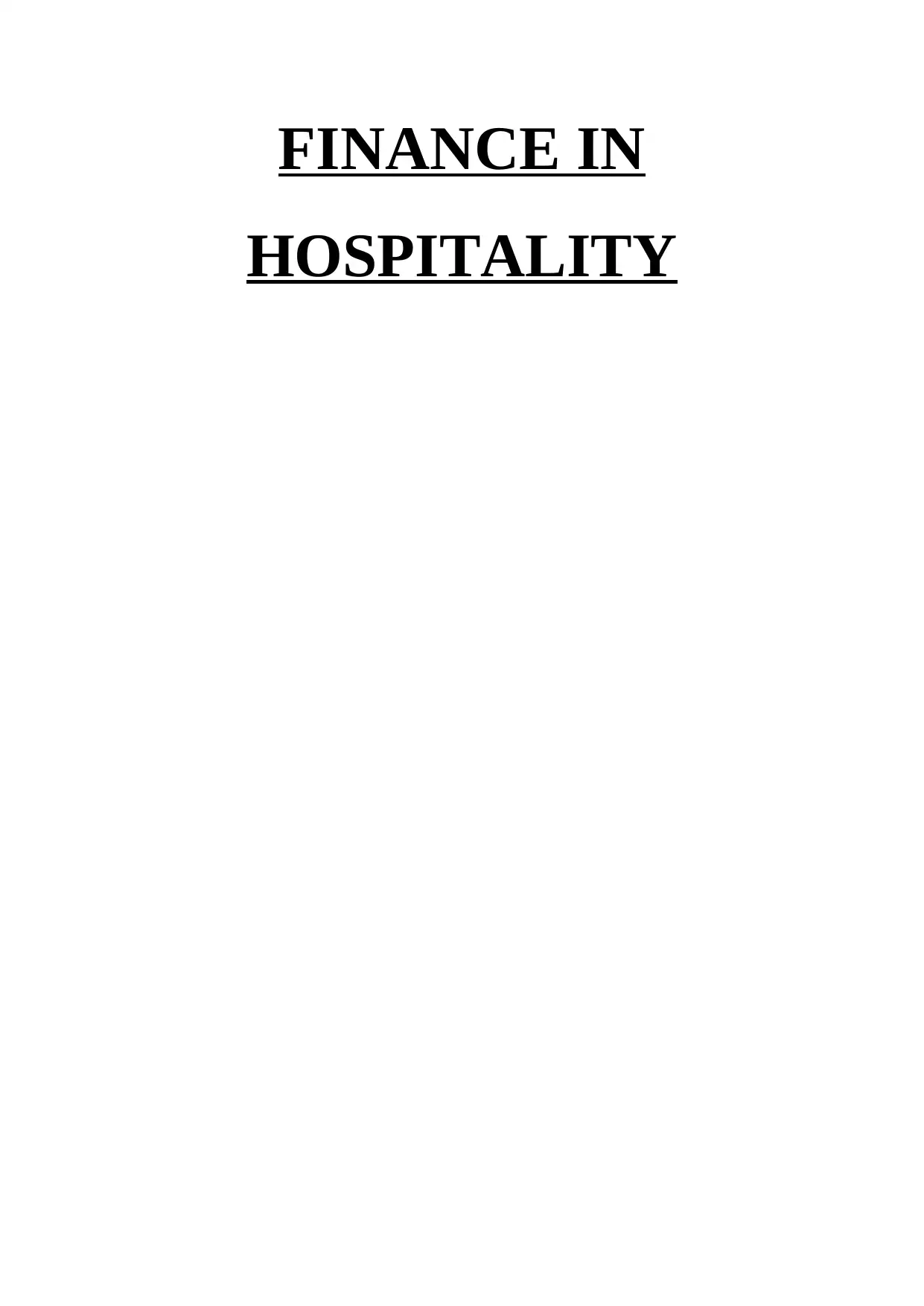
FINANCE IN
HOSPITALITY
HOSPITALITY
Secure Best Marks with AI Grader
Need help grading? Try our AI Grader for instant feedback on your assignments.
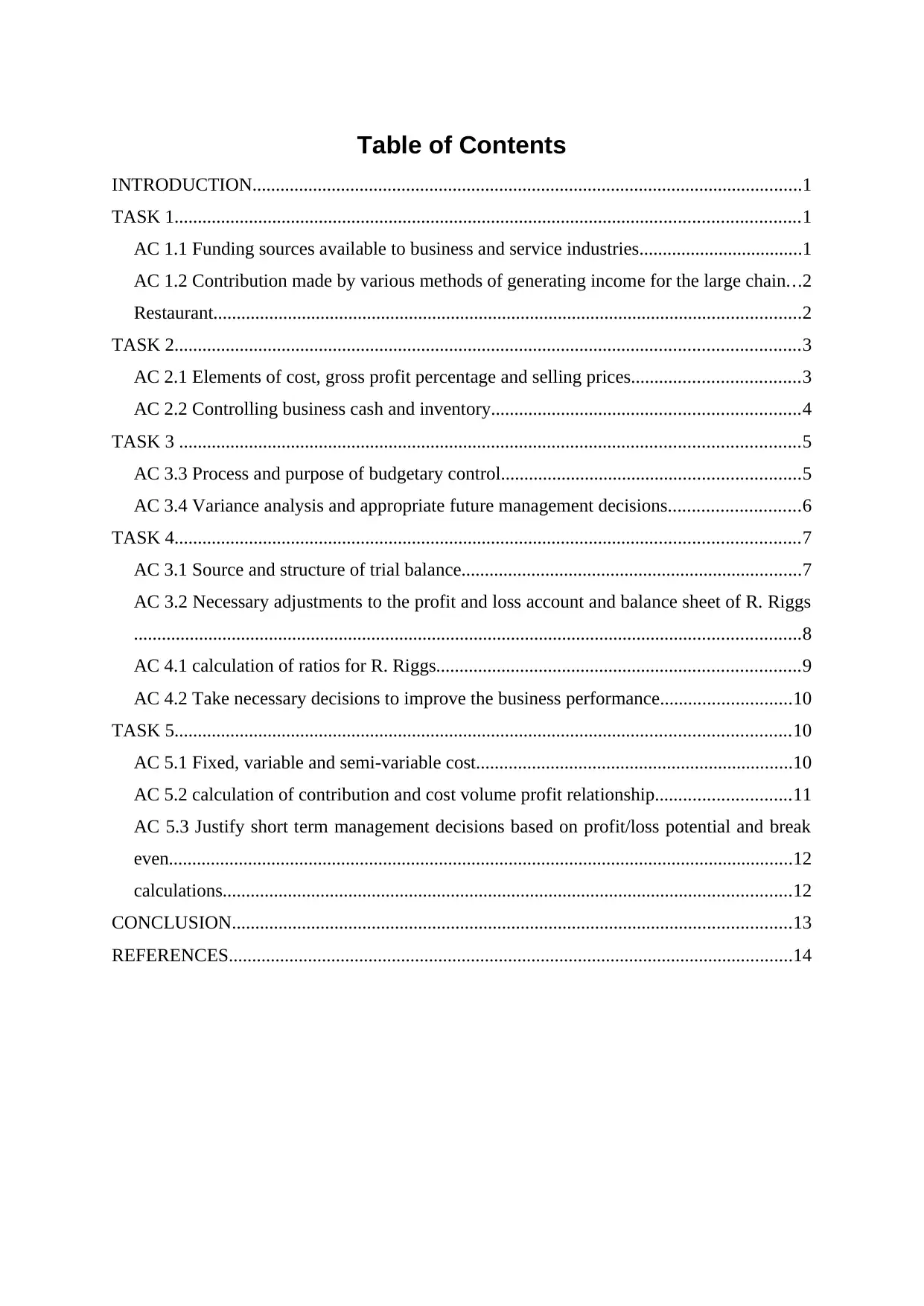
Table of Contents
INTRODUCTION......................................................................................................................1
TASK 1......................................................................................................................................1
AC 1.1 Funding sources available to business and service industries...................................1
AC 1.2 Contribution made by various methods of generating income for the large chain...2
Restaurant..............................................................................................................................2
TASK 2......................................................................................................................................3
AC 2.1 Elements of cost, gross profit percentage and selling prices....................................3
AC 2.2 Controlling business cash and inventory..................................................................4
TASK 3 .....................................................................................................................................5
AC 3.3 Process and purpose of budgetary control................................................................5
AC 3.4 Variance analysis and appropriate future management decisions............................6
TASK 4......................................................................................................................................7
AC 3.1 Source and structure of trial balance.........................................................................7
AC 3.2 Necessary adjustments to the profit and loss account and balance sheet of R. Riggs
...............................................................................................................................................8
AC 4.1 calculation of ratios for R. Riggs..............................................................................9
AC 4.2 Take necessary decisions to improve the business performance............................10
TASK 5....................................................................................................................................10
AC 5.1 Fixed, variable and semi-variable cost....................................................................10
AC 5.2 calculation of contribution and cost volume profit relationship.............................11
AC 5.3 Justify short term management decisions based on profit/loss potential and break
even......................................................................................................................................12
calculations..........................................................................................................................12
CONCLUSION........................................................................................................................13
REFERENCES.........................................................................................................................14
INTRODUCTION......................................................................................................................1
TASK 1......................................................................................................................................1
AC 1.1 Funding sources available to business and service industries...................................1
AC 1.2 Contribution made by various methods of generating income for the large chain...2
Restaurant..............................................................................................................................2
TASK 2......................................................................................................................................3
AC 2.1 Elements of cost, gross profit percentage and selling prices....................................3
AC 2.2 Controlling business cash and inventory..................................................................4
TASK 3 .....................................................................................................................................5
AC 3.3 Process and purpose of budgetary control................................................................5
AC 3.4 Variance analysis and appropriate future management decisions............................6
TASK 4......................................................................................................................................7
AC 3.1 Source and structure of trial balance.........................................................................7
AC 3.2 Necessary adjustments to the profit and loss account and balance sheet of R. Riggs
...............................................................................................................................................8
AC 4.1 calculation of ratios for R. Riggs..............................................................................9
AC 4.2 Take necessary decisions to improve the business performance............................10
TASK 5....................................................................................................................................10
AC 5.1 Fixed, variable and semi-variable cost....................................................................10
AC 5.2 calculation of contribution and cost volume profit relationship.............................11
AC 5.3 Justify short term management decisions based on profit/loss potential and break
even......................................................................................................................................12
calculations..........................................................................................................................12
CONCLUSION........................................................................................................................13
REFERENCES.........................................................................................................................14
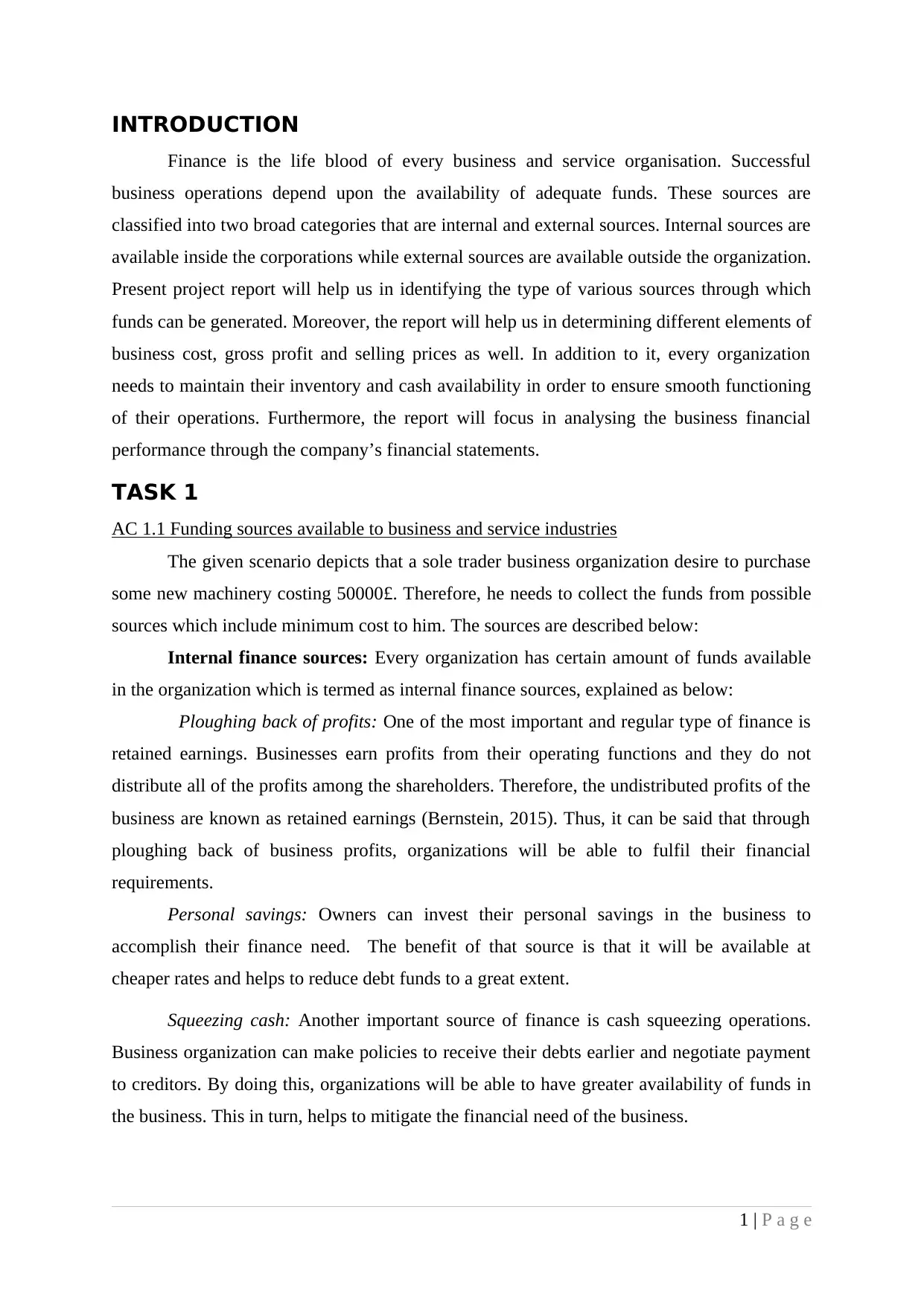
INTRODUCTION
Finance is the life blood of every business and service organisation. Successful
business operations depend upon the availability of adequate funds. These sources are
classified into two broad categories that are internal and external sources. Internal sources are
available inside the corporations while external sources are available outside the organization.
Present project report will help us in identifying the type of various sources through which
funds can be generated. Moreover, the report will help us in determining different elements of
business cost, gross profit and selling prices as well. In addition to it, every organization
needs to maintain their inventory and cash availability in order to ensure smooth functioning
of their operations. Furthermore, the report will focus in analysing the business financial
performance through the company’s financial statements.
TASK 1
AC 1.1 Funding sources available to business and service industries
The given scenario depicts that a sole trader business organization desire to purchase
some new machinery costing 50000£. Therefore, he needs to collect the funds from possible
sources which include minimum cost to him. The sources are described below:
Internal finance sources: Every organization has certain amount of funds available
in the organization which is termed as internal finance sources, explained as below:
Ploughing back of profits: One of the most important and regular type of finance is
retained earnings. Businesses earn profits from their operating functions and they do not
distribute all of the profits among the shareholders. Therefore, the undistributed profits of the
business are known as retained earnings (Bernstein, 2015). Thus, it can be said that through
ploughing back of business profits, organizations will be able to fulfil their financial
requirements.
Personal savings: Owners can invest their personal savings in the business to
accomplish their finance need. The benefit of that source is that it will be available at
cheaper rates and helps to reduce debt funds to a great extent.
Squeezing cash: Another important source of finance is cash squeezing operations.
Business organization can make policies to receive their debts earlier and negotiate payment
to creditors. By doing this, organizations will be able to have greater availability of funds in
the business. This in turn, helps to mitigate the financial need of the business.
1 | P a g e
Finance is the life blood of every business and service organisation. Successful
business operations depend upon the availability of adequate funds. These sources are
classified into two broad categories that are internal and external sources. Internal sources are
available inside the corporations while external sources are available outside the organization.
Present project report will help us in identifying the type of various sources through which
funds can be generated. Moreover, the report will help us in determining different elements of
business cost, gross profit and selling prices as well. In addition to it, every organization
needs to maintain their inventory and cash availability in order to ensure smooth functioning
of their operations. Furthermore, the report will focus in analysing the business financial
performance through the company’s financial statements.
TASK 1
AC 1.1 Funding sources available to business and service industries
The given scenario depicts that a sole trader business organization desire to purchase
some new machinery costing 50000£. Therefore, he needs to collect the funds from possible
sources which include minimum cost to him. The sources are described below:
Internal finance sources: Every organization has certain amount of funds available
in the organization which is termed as internal finance sources, explained as below:
Ploughing back of profits: One of the most important and regular type of finance is
retained earnings. Businesses earn profits from their operating functions and they do not
distribute all of the profits among the shareholders. Therefore, the undistributed profits of the
business are known as retained earnings (Bernstein, 2015). Thus, it can be said that through
ploughing back of business profits, organizations will be able to fulfil their financial
requirements.
Personal savings: Owners can invest their personal savings in the business to
accomplish their finance need. The benefit of that source is that it will be available at
cheaper rates and helps to reduce debt funds to a great extent.
Squeezing cash: Another important source of finance is cash squeezing operations.
Business organization can make policies to receive their debts earlier and negotiate payment
to creditors. By doing this, organizations will be able to have greater availability of funds in
the business. This in turn, helps to mitigate the financial need of the business.
1 | P a g e
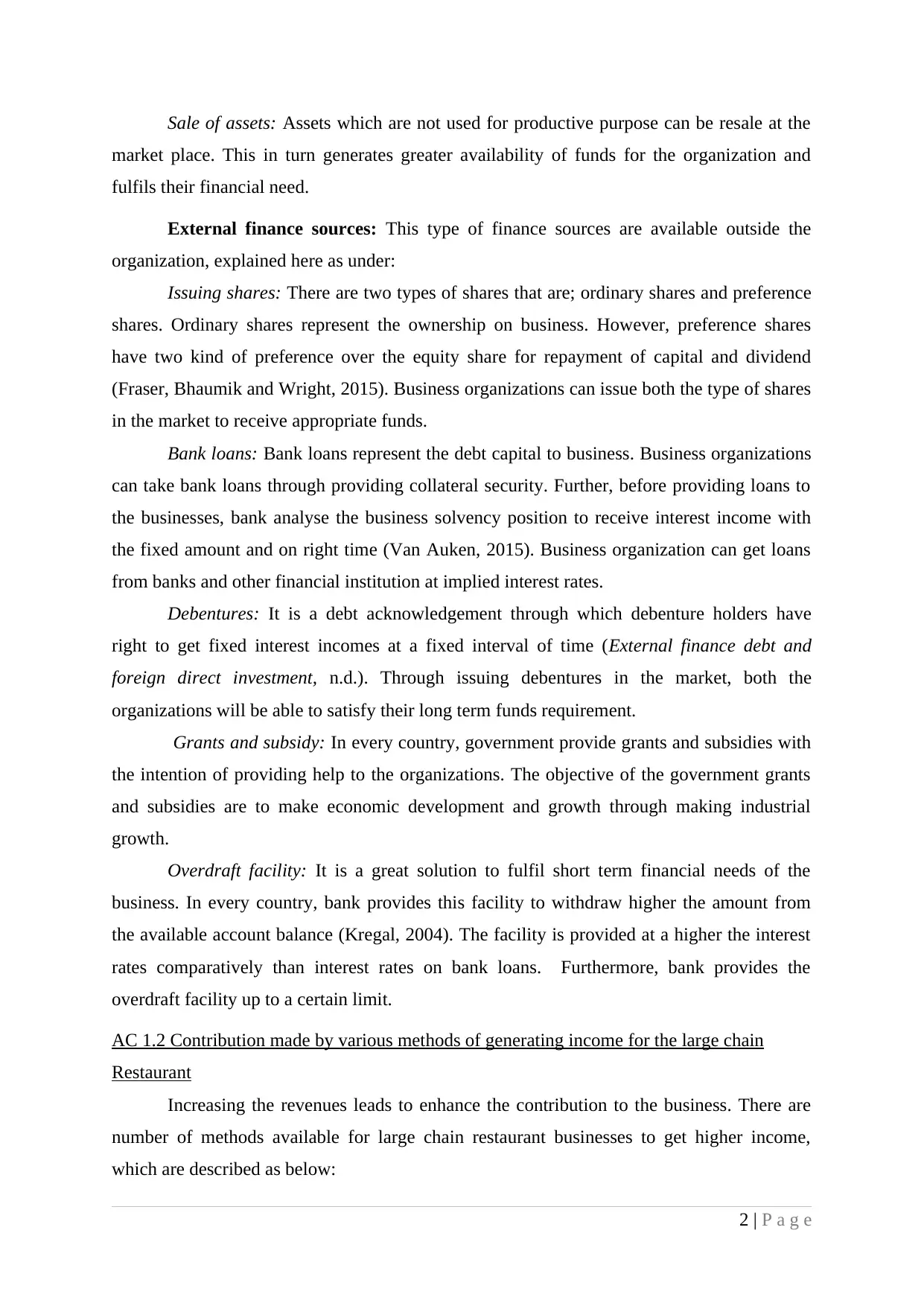
Sale of assets: Assets which are not used for productive purpose can be resale at the
market place. This in turn generates greater availability of funds for the organization and
fulfils their financial need.
External finance sources: This type of finance sources are available outside the
organization, explained here as under:
Issuing shares: There are two types of shares that are; ordinary shares and preference
shares. Ordinary shares represent the ownership on business. However, preference shares
have two kind of preference over the equity share for repayment of capital and dividend
(Fraser, Bhaumik and Wright, 2015). Business organizations can issue both the type of shares
in the market to receive appropriate funds.
Bank loans: Bank loans represent the debt capital to business. Business organizations
can take bank loans through providing collateral security. Further, before providing loans to
the businesses, bank analyse the business solvency position to receive interest income with
the fixed amount and on right time (Van Auken, 2015). Business organization can get loans
from banks and other financial institution at implied interest rates.
Debentures: It is a debt acknowledgement through which debenture holders have
right to get fixed interest incomes at a fixed interval of time (External finance debt and
foreign direct investment, n.d.). Through issuing debentures in the market, both the
organizations will be able to satisfy their long term funds requirement.
Grants and subsidy: In every country, government provide grants and subsidies with
the intention of providing help to the organizations. The objective of the government grants
and subsidies are to make economic development and growth through making industrial
growth.
Overdraft facility: It is a great solution to fulfil short term financial needs of the
business. In every country, bank provides this facility to withdraw higher the amount from
the available account balance (Kregal, 2004). The facility is provided at a higher the interest
rates comparatively than interest rates on bank loans. Furthermore, bank provides the
overdraft facility up to a certain limit.
AC 1.2 Contribution made by various methods of generating income for the large chain
Restaurant
Increasing the revenues leads to enhance the contribution to the business. There are
number of methods available for large chain restaurant businesses to get higher income,
which are described as below:
2 | P a g e
market place. This in turn generates greater availability of funds for the organization and
fulfils their financial need.
External finance sources: This type of finance sources are available outside the
organization, explained here as under:
Issuing shares: There are two types of shares that are; ordinary shares and preference
shares. Ordinary shares represent the ownership on business. However, preference shares
have two kind of preference over the equity share for repayment of capital and dividend
(Fraser, Bhaumik and Wright, 2015). Business organizations can issue both the type of shares
in the market to receive appropriate funds.
Bank loans: Bank loans represent the debt capital to business. Business organizations
can take bank loans through providing collateral security. Further, before providing loans to
the businesses, bank analyse the business solvency position to receive interest income with
the fixed amount and on right time (Van Auken, 2015). Business organization can get loans
from banks and other financial institution at implied interest rates.
Debentures: It is a debt acknowledgement through which debenture holders have
right to get fixed interest incomes at a fixed interval of time (External finance debt and
foreign direct investment, n.d.). Through issuing debentures in the market, both the
organizations will be able to satisfy their long term funds requirement.
Grants and subsidy: In every country, government provide grants and subsidies with
the intention of providing help to the organizations. The objective of the government grants
and subsidies are to make economic development and growth through making industrial
growth.
Overdraft facility: It is a great solution to fulfil short term financial needs of the
business. In every country, bank provides this facility to withdraw higher the amount from
the available account balance (Kregal, 2004). The facility is provided at a higher the interest
rates comparatively than interest rates on bank loans. Furthermore, bank provides the
overdraft facility up to a certain limit.
AC 1.2 Contribution made by various methods of generating income for the large chain
Restaurant
Increasing the revenues leads to enhance the contribution to the business. There are
number of methods available for large chain restaurant businesses to get higher income,
which are described as below:
2 | P a g e
Secure Best Marks with AI Grader
Need help grading? Try our AI Grader for instant feedback on your assignments.
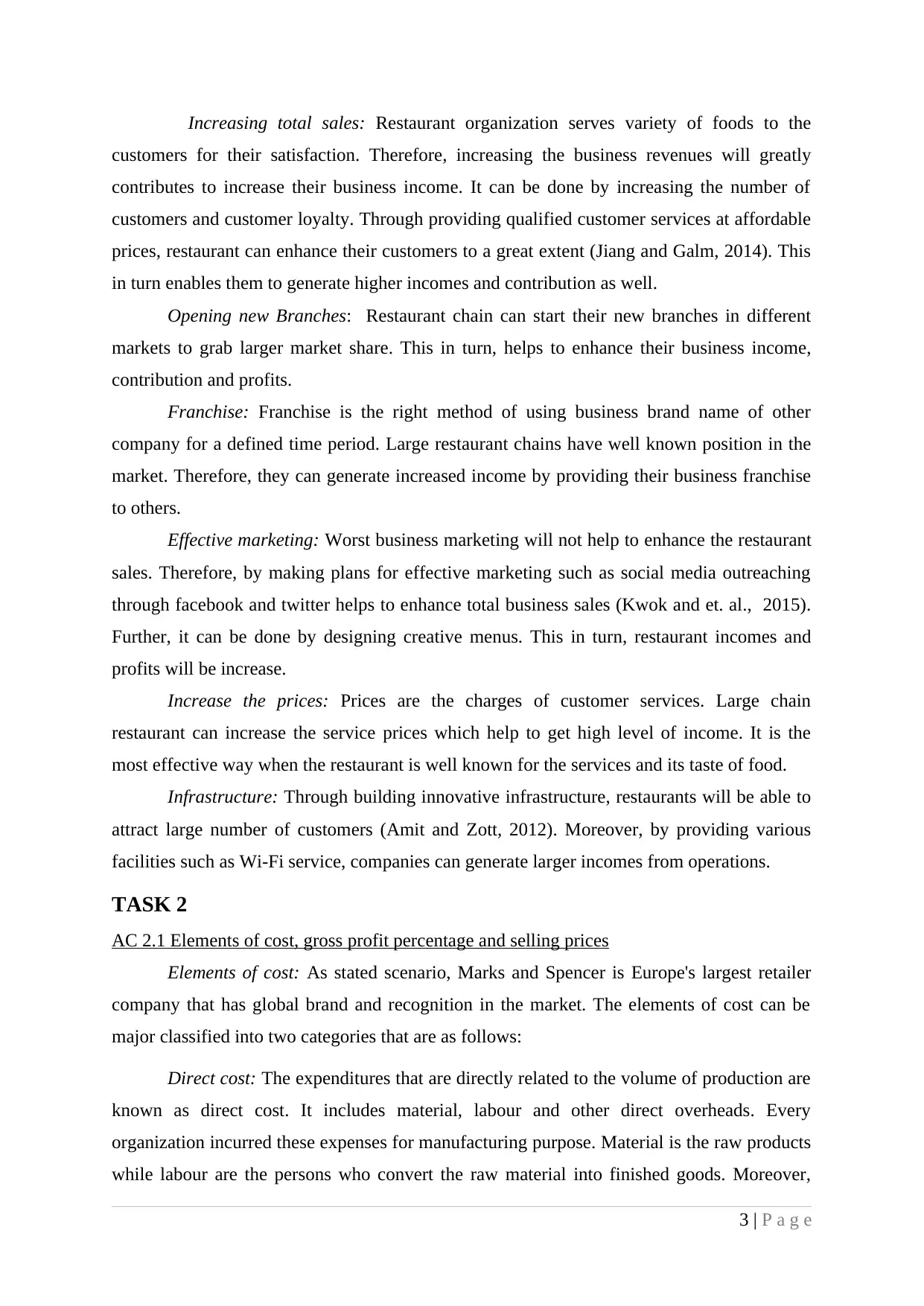
Increasing total sales: Restaurant organization serves variety of foods to the
customers for their satisfaction. Therefore, increasing the business revenues will greatly
contributes to increase their business income. It can be done by increasing the number of
customers and customer loyalty. Through providing qualified customer services at affordable
prices, restaurant can enhance their customers to a great extent (Jiang and Galm, 2014). This
in turn enables them to generate higher incomes and contribution as well.
Opening new Branches: Restaurant chain can start their new branches in different
markets to grab larger market share. This in turn, helps to enhance their business income,
contribution and profits.
Franchise: Franchise is the right method of using business brand name of other
company for a defined time period. Large restaurant chains have well known position in the
market. Therefore, they can generate increased income by providing their business franchise
to others.
Effective marketing: Worst business marketing will not help to enhance the restaurant
sales. Therefore, by making plans for effective marketing such as social media outreaching
through facebook and twitter helps to enhance total business sales (Kwok and et. al., 2015).
Further, it can be done by designing creative menus. This in turn, restaurant incomes and
profits will be increase.
Increase the prices: Prices are the charges of customer services. Large chain
restaurant can increase the service prices which help to get high level of income. It is the
most effective way when the restaurant is well known for the services and its taste of food.
Infrastructure: Through building innovative infrastructure, restaurants will be able to
attract large number of customers (Amit and Zott, 2012). Moreover, by providing various
facilities such as Wi-Fi service, companies can generate larger incomes from operations.
TASK 2
AC 2.1 Elements of cost, gross profit percentage and selling prices
Elements of cost: As stated scenario, Marks and Spencer is Europe's largest retailer
company that has global brand and recognition in the market. The elements of cost can be
major classified into two categories that are as follows:
Direct cost: The expenditures that are directly related to the volume of production are
known as direct cost. It includes material, labour and other direct overheads. Every
organization incurred these expenses for manufacturing purpose. Material is the raw products
while labour are the persons who convert the raw material into finished goods. Moreover,
3 | P a g e
customers for their satisfaction. Therefore, increasing the business revenues will greatly
contributes to increase their business income. It can be done by increasing the number of
customers and customer loyalty. Through providing qualified customer services at affordable
prices, restaurant can enhance their customers to a great extent (Jiang and Galm, 2014). This
in turn enables them to generate higher incomes and contribution as well.
Opening new Branches: Restaurant chain can start their new branches in different
markets to grab larger market share. This in turn, helps to enhance their business income,
contribution and profits.
Franchise: Franchise is the right method of using business brand name of other
company for a defined time period. Large restaurant chains have well known position in the
market. Therefore, they can generate increased income by providing their business franchise
to others.
Effective marketing: Worst business marketing will not help to enhance the restaurant
sales. Therefore, by making plans for effective marketing such as social media outreaching
through facebook and twitter helps to enhance total business sales (Kwok and et. al., 2015).
Further, it can be done by designing creative menus. This in turn, restaurant incomes and
profits will be increase.
Increase the prices: Prices are the charges of customer services. Large chain
restaurant can increase the service prices which help to get high level of income. It is the
most effective way when the restaurant is well known for the services and its taste of food.
Infrastructure: Through building innovative infrastructure, restaurants will be able to
attract large number of customers (Amit and Zott, 2012). Moreover, by providing various
facilities such as Wi-Fi service, companies can generate larger incomes from operations.
TASK 2
AC 2.1 Elements of cost, gross profit percentage and selling prices
Elements of cost: As stated scenario, Marks and Spencer is Europe's largest retailer
company that has global brand and recognition in the market. The elements of cost can be
major classified into two categories that are as follows:
Direct cost: The expenditures that are directly related to the volume of production are
known as direct cost. It includes material, labour and other direct overheads. Every
organization incurred these expenses for manufacturing purpose. Material is the raw products
while labour are the persons who convert the raw material into finished goods. Moreover,
3 | P a g e
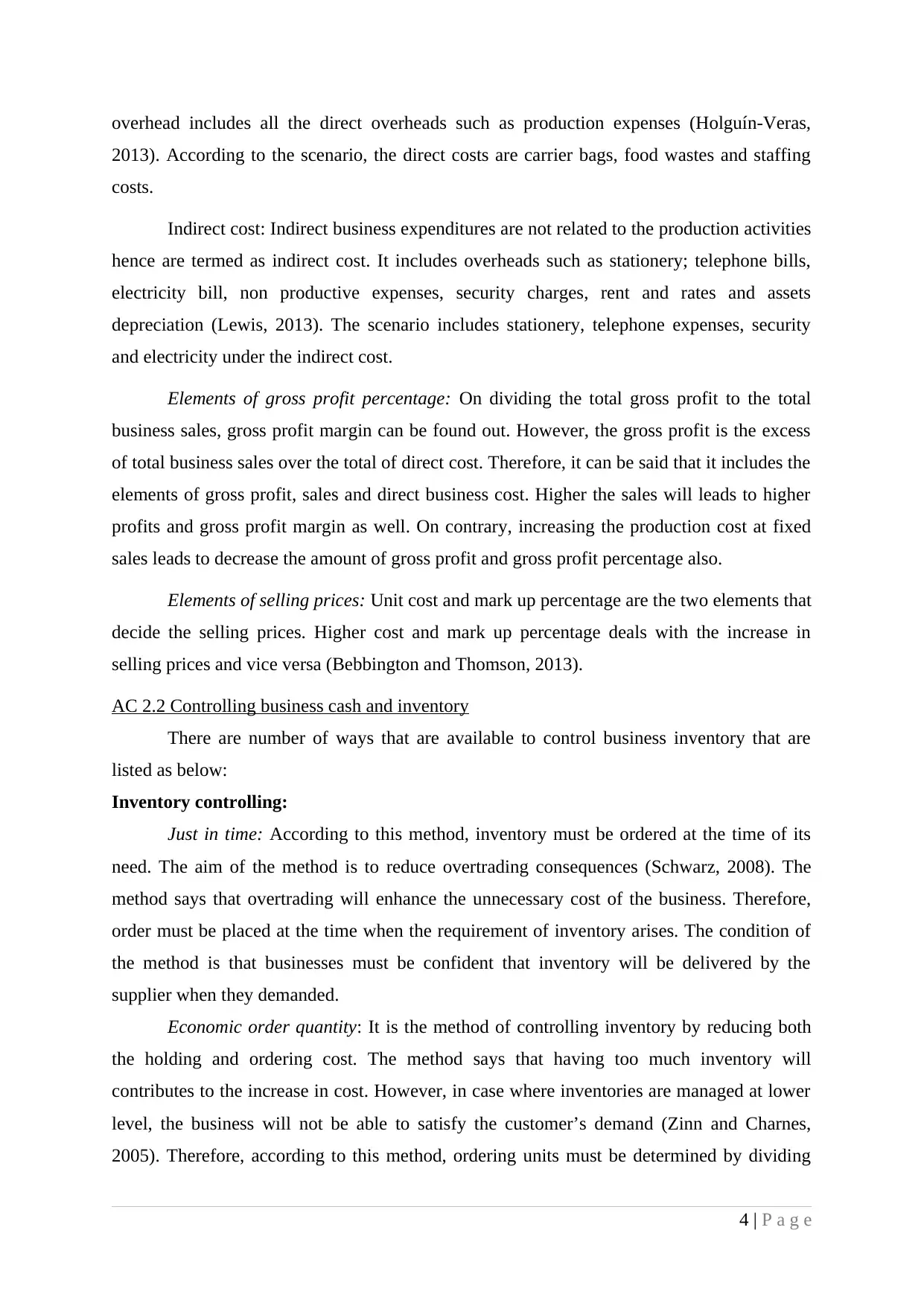
overhead includes all the direct overheads such as production expenses (Holguín-Veras,
2013). According to the scenario, the direct costs are carrier bags, food wastes and staffing
costs.
Indirect cost: Indirect business expenditures are not related to the production activities
hence are termed as indirect cost. It includes overheads such as stationery; telephone bills,
electricity bill, non productive expenses, security charges, rent and rates and assets
depreciation (Lewis, 2013). The scenario includes stationery, telephone expenses, security
and electricity under the indirect cost.
Elements of gross profit percentage: On dividing the total gross profit to the total
business sales, gross profit margin can be found out. However, the gross profit is the excess
of total business sales over the total of direct cost. Therefore, it can be said that it includes the
elements of gross profit, sales and direct business cost. Higher the sales will leads to higher
profits and gross profit margin as well. On contrary, increasing the production cost at fixed
sales leads to decrease the amount of gross profit and gross profit percentage also.
Elements of selling prices: Unit cost and mark up percentage are the two elements that
decide the selling prices. Higher cost and mark up percentage deals with the increase in
selling prices and vice versa (Bebbington and Thomson, 2013).
AC 2.2 Controlling business cash and inventory
There are number of ways that are available to control business inventory that are
listed as below:
Inventory controlling:
Just in time: According to this method, inventory must be ordered at the time of its
need. The aim of the method is to reduce overtrading consequences (Schwarz, 2008). The
method says that overtrading will enhance the unnecessary cost of the business. Therefore,
order must be placed at the time when the requirement of inventory arises. The condition of
the method is that businesses must be confident that inventory will be delivered by the
supplier when they demanded.
Economic order quantity: It is the method of controlling inventory by reducing both
the holding and ordering cost. The method says that having too much inventory will
contributes to the increase in cost. However, in case where inventories are managed at lower
level, the business will not be able to satisfy the customer’s demand (Zinn and Charnes,
2005). Therefore, according to this method, ordering units must be determined by dividing
4 | P a g e
2013). According to the scenario, the direct costs are carrier bags, food wastes and staffing
costs.
Indirect cost: Indirect business expenditures are not related to the production activities
hence are termed as indirect cost. It includes overheads such as stationery; telephone bills,
electricity bill, non productive expenses, security charges, rent and rates and assets
depreciation (Lewis, 2013). The scenario includes stationery, telephone expenses, security
and electricity under the indirect cost.
Elements of gross profit percentage: On dividing the total gross profit to the total
business sales, gross profit margin can be found out. However, the gross profit is the excess
of total business sales over the total of direct cost. Therefore, it can be said that it includes the
elements of gross profit, sales and direct business cost. Higher the sales will leads to higher
profits and gross profit margin as well. On contrary, increasing the production cost at fixed
sales leads to decrease the amount of gross profit and gross profit percentage also.
Elements of selling prices: Unit cost and mark up percentage are the two elements that
decide the selling prices. Higher cost and mark up percentage deals with the increase in
selling prices and vice versa (Bebbington and Thomson, 2013).
AC 2.2 Controlling business cash and inventory
There are number of ways that are available to control business inventory that are
listed as below:
Inventory controlling:
Just in time: According to this method, inventory must be ordered at the time of its
need. The aim of the method is to reduce overtrading consequences (Schwarz, 2008). The
method says that overtrading will enhance the unnecessary cost of the business. Therefore,
order must be placed at the time when the requirement of inventory arises. The condition of
the method is that businesses must be confident that inventory will be delivered by the
supplier when they demanded.
Economic order quantity: It is the method of controlling inventory by reducing both
the holding and ordering cost. The method says that having too much inventory will
contributes to the increase in cost. However, in case where inventories are managed at lower
level, the business will not be able to satisfy the customer’s demand (Zinn and Charnes,
2005). Therefore, according to this method, ordering units must be determined by dividing
4 | P a g e
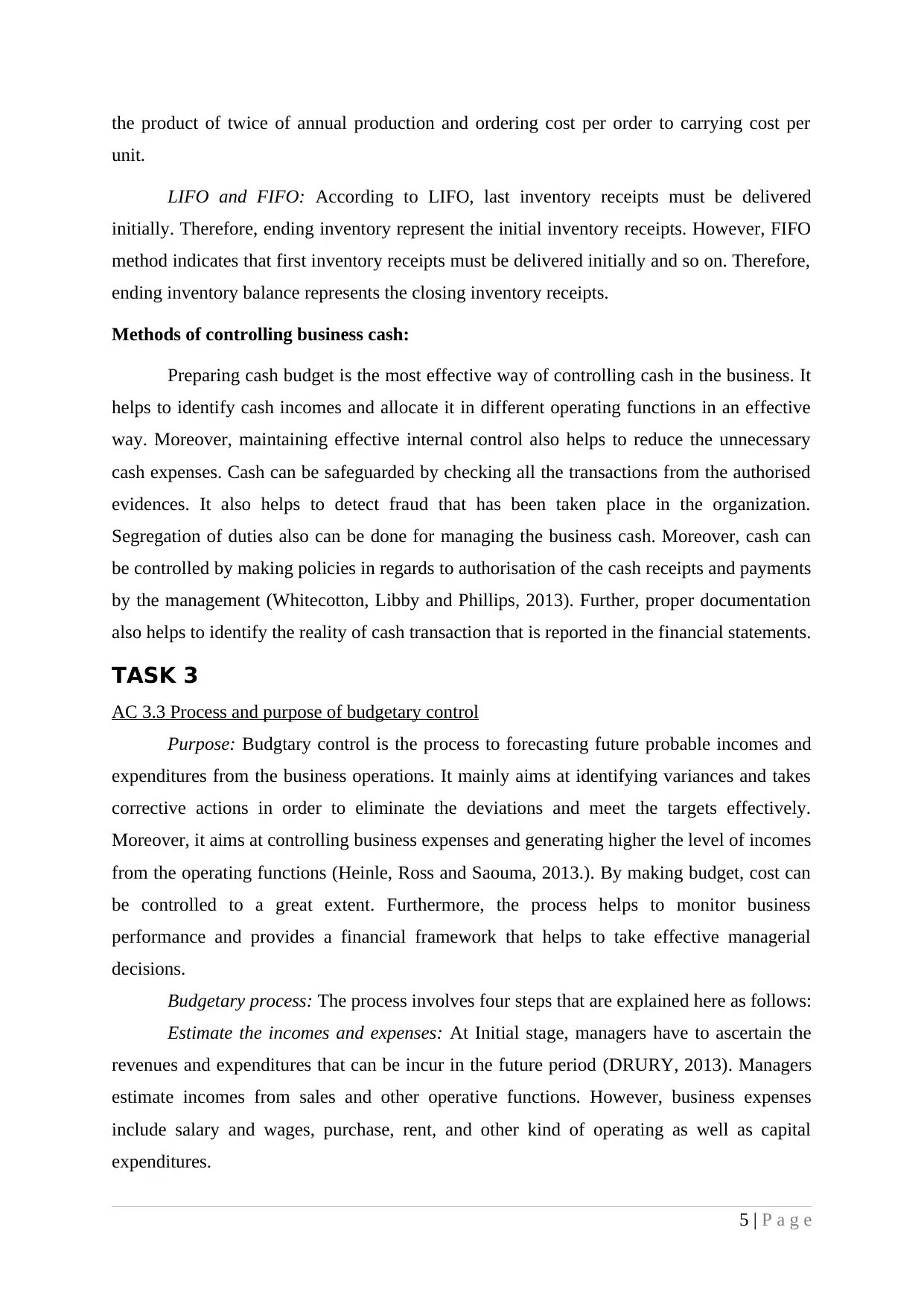
the product of twice of annual production and ordering cost per order to carrying cost per
unit.
LIFO and FIFO: According to LIFO, last inventory receipts must be delivered
initially. Therefore, ending inventory represent the initial inventory receipts. However, FIFO
method indicates that first inventory receipts must be delivered initially and so on. Therefore,
ending inventory balance represents the closing inventory receipts.
Methods of controlling business cash:
Preparing cash budget is the most effective way of controlling cash in the business. It
helps to identify cash incomes and allocate it in different operating functions in an effective
way. Moreover, maintaining effective internal control also helps to reduce the unnecessary
cash expenses. Cash can be safeguarded by checking all the transactions from the authorised
evidences. It also helps to detect fraud that has been taken place in the organization.
Segregation of duties also can be done for managing the business cash. Moreover, cash can
be controlled by making policies in regards to authorisation of the cash receipts and payments
by the management (Whitecotton, Libby and Phillips, 2013). Further, proper documentation
also helps to identify the reality of cash transaction that is reported in the financial statements.
TASK 3
AC 3.3 Process and purpose of budgetary control
Purpose: Budgtary control is the process to forecasting future probable incomes and
expenditures from the business operations. It mainly aims at identifying variances and takes
corrective actions in order to eliminate the deviations and meet the targets effectively.
Moreover, it aims at controlling business expenses and generating higher the level of incomes
from the operating functions (Heinle, Ross and Saouma, 2013.). By making budget, cost can
be controlled to a great extent. Furthermore, the process helps to monitor business
performance and provides a financial framework that helps to take effective managerial
decisions.
Budgetary process: The process involves four steps that are explained here as follows:
Estimate the incomes and expenses: At Initial stage, managers have to ascertain the
revenues and expenditures that can be incur in the future period (DRURY, 2013). Managers
estimate incomes from sales and other operative functions. However, business expenses
include salary and wages, purchase, rent, and other kind of operating as well as capital
expenditures.
5 | P a g e
unit.
LIFO and FIFO: According to LIFO, last inventory receipts must be delivered
initially. Therefore, ending inventory represent the initial inventory receipts. However, FIFO
method indicates that first inventory receipts must be delivered initially and so on. Therefore,
ending inventory balance represents the closing inventory receipts.
Methods of controlling business cash:
Preparing cash budget is the most effective way of controlling cash in the business. It
helps to identify cash incomes and allocate it in different operating functions in an effective
way. Moreover, maintaining effective internal control also helps to reduce the unnecessary
cash expenses. Cash can be safeguarded by checking all the transactions from the authorised
evidences. It also helps to detect fraud that has been taken place in the organization.
Segregation of duties also can be done for managing the business cash. Moreover, cash can
be controlled by making policies in regards to authorisation of the cash receipts and payments
by the management (Whitecotton, Libby and Phillips, 2013). Further, proper documentation
also helps to identify the reality of cash transaction that is reported in the financial statements.
TASK 3
AC 3.3 Process and purpose of budgetary control
Purpose: Budgtary control is the process to forecasting future probable incomes and
expenditures from the business operations. It mainly aims at identifying variances and takes
corrective actions in order to eliminate the deviations and meet the targets effectively.
Moreover, it aims at controlling business expenses and generating higher the level of incomes
from the operating functions (Heinle, Ross and Saouma, 2013.). By making budget, cost can
be controlled to a great extent. Furthermore, the process helps to monitor business
performance and provides a financial framework that helps to take effective managerial
decisions.
Budgetary process: The process involves four steps that are explained here as follows:
Estimate the incomes and expenses: At Initial stage, managers have to ascertain the
revenues and expenditures that can be incur in the future period (DRURY, 2013). Managers
estimate incomes from sales and other operative functions. However, business expenses
include salary and wages, purchase, rent, and other kind of operating as well as capital
expenditures.
5 | P a g e
Paraphrase This Document
Need a fresh take? Get an instant paraphrase of this document with our AI Paraphraser
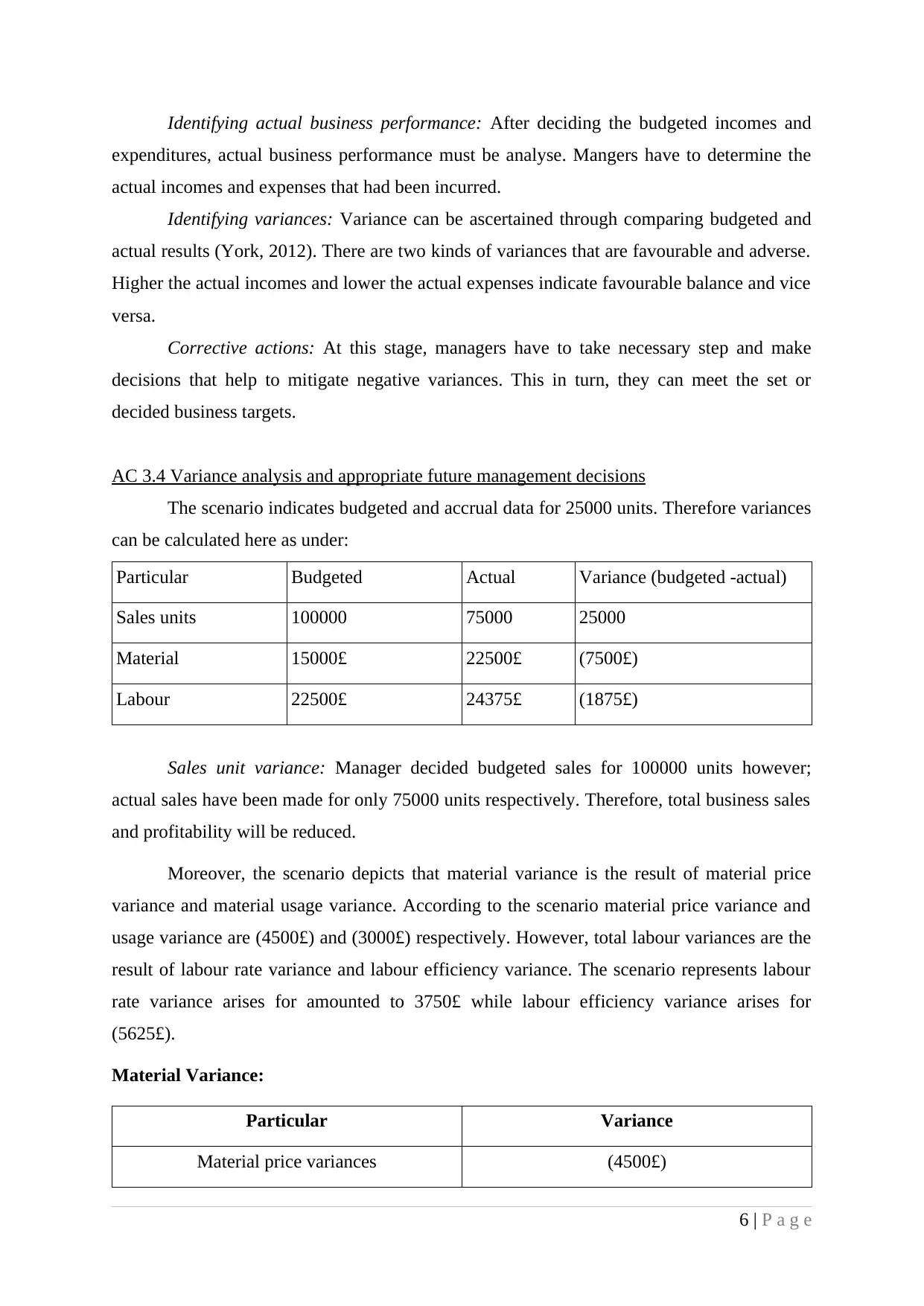
Identifying actual business performance: After deciding the budgeted incomes and
expenditures, actual business performance must be analyse. Mangers have to determine the
actual incomes and expenses that had been incurred.
Identifying variances: Variance can be ascertained through comparing budgeted and
actual results (York, 2012). There are two kinds of variances that are favourable and adverse.
Higher the actual incomes and lower the actual expenses indicate favourable balance and vice
versa.
Corrective actions: At this stage, managers have to take necessary step and make
decisions that help to mitigate negative variances. This in turn, they can meet the set or
decided business targets.
AC 3.4 Variance analysis and appropriate future management decisions
The scenario indicates budgeted and accrual data for 25000 units. Therefore variances
can be calculated here as under:
Particular Budgeted Actual Variance (budgeted -actual)
Sales units 100000 75000 25000
Material 15000£ 22500£ (7500£)
Labour 22500£ 24375£ (1875£)
Sales unit variance: Manager decided budgeted sales for 100000 units however;
actual sales have been made for only 75000 units respectively. Therefore, total business sales
and profitability will be reduced.
Moreover, the scenario depicts that material variance is the result of material price
variance and material usage variance. According to the scenario material price variance and
usage variance are (4500£) and (3000£) respectively. However, total labour variances are the
result of labour rate variance and labour efficiency variance. The scenario represents labour
rate variance arises for amounted to 3750£ while labour efficiency variance arises for
(5625£).
Material Variance:
Particular Variance
Material price variances (4500£)
6 | P a g e
expenditures, actual business performance must be analyse. Mangers have to determine the
actual incomes and expenses that had been incurred.
Identifying variances: Variance can be ascertained through comparing budgeted and
actual results (York, 2012). There are two kinds of variances that are favourable and adverse.
Higher the actual incomes and lower the actual expenses indicate favourable balance and vice
versa.
Corrective actions: At this stage, managers have to take necessary step and make
decisions that help to mitigate negative variances. This in turn, they can meet the set or
decided business targets.
AC 3.4 Variance analysis and appropriate future management decisions
The scenario indicates budgeted and accrual data for 25000 units. Therefore variances
can be calculated here as under:
Particular Budgeted Actual Variance (budgeted -actual)
Sales units 100000 75000 25000
Material 15000£ 22500£ (7500£)
Labour 22500£ 24375£ (1875£)
Sales unit variance: Manager decided budgeted sales for 100000 units however;
actual sales have been made for only 75000 units respectively. Therefore, total business sales
and profitability will be reduced.
Moreover, the scenario depicts that material variance is the result of material price
variance and material usage variance. According to the scenario material price variance and
usage variance are (4500£) and (3000£) respectively. However, total labour variances are the
result of labour rate variance and labour efficiency variance. The scenario represents labour
rate variance arises for amounted to 3750£ while labour efficiency variance arises for
(5625£).
Material Variance:
Particular Variance
Material price variances (4500£)
6 | P a g e
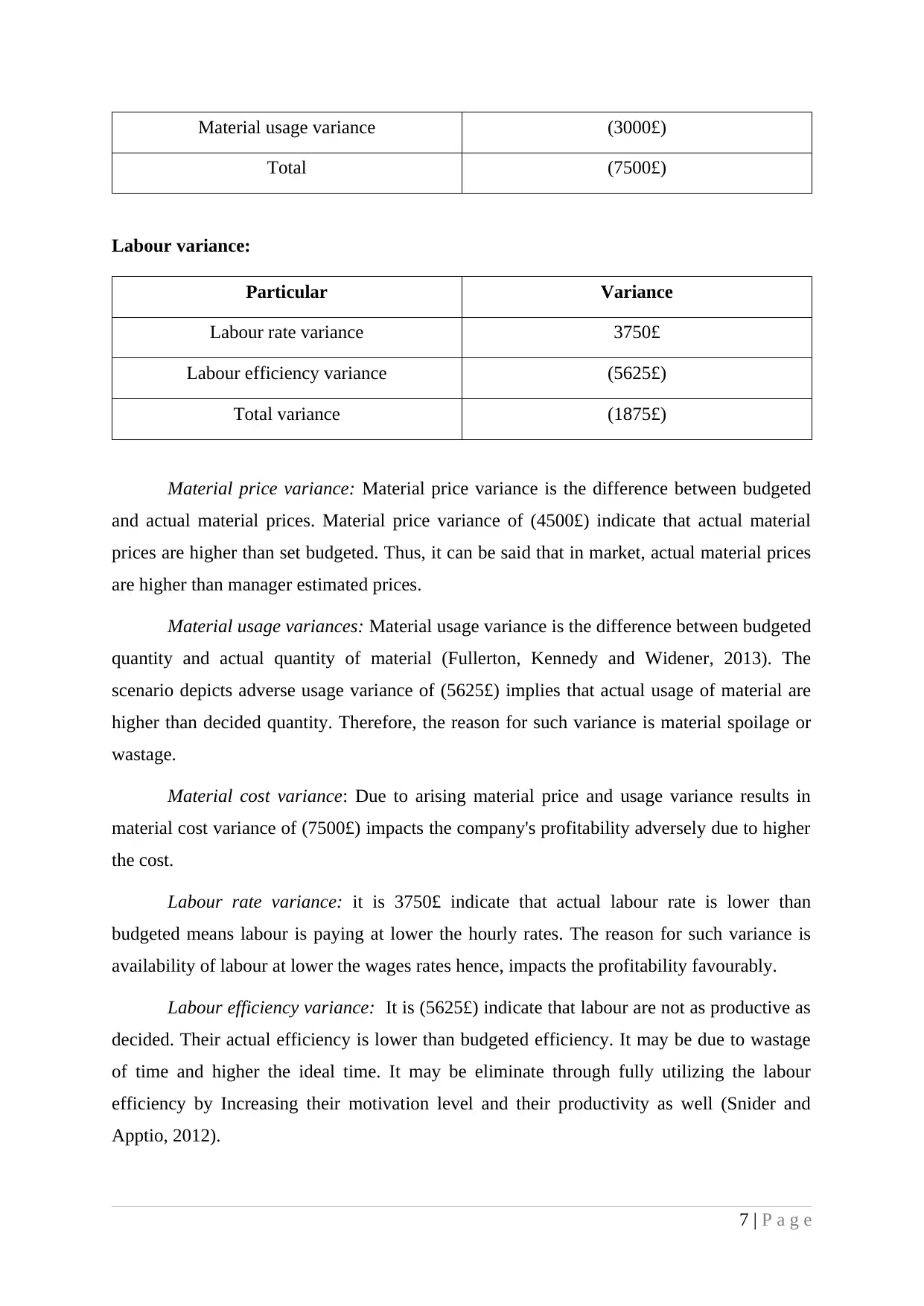
Material usage variance (3000£)
Total (7500£)
Labour variance:
Particular Variance
Labour rate variance 3750£
Labour efficiency variance (5625£)
Total variance (1875£)
Material price variance: Material price variance is the difference between budgeted
and actual material prices. Material price variance of (4500£) indicate that actual material
prices are higher than set budgeted. Thus, it can be said that in market, actual material prices
are higher than manager estimated prices.
Material usage variances: Material usage variance is the difference between budgeted
quantity and actual quantity of material (Fullerton, Kennedy and Widener, 2013). The
scenario depicts adverse usage variance of (5625£) implies that actual usage of material are
higher than decided quantity. Therefore, the reason for such variance is material spoilage or
wastage.
Material cost variance: Due to arising material price and usage variance results in
material cost variance of (7500£) impacts the company's profitability adversely due to higher
the cost.
Labour rate variance: it is 3750£ indicate that actual labour rate is lower than
budgeted means labour is paying at lower the hourly rates. The reason for such variance is
availability of labour at lower the wages rates hence, impacts the profitability favourably.
Labour efficiency variance: It is (5625£) indicate that labour are not as productive as
decided. Their actual efficiency is lower than budgeted efficiency. It may be due to wastage
of time and higher the ideal time. It may be eliminate through fully utilizing the labour
efficiency by Increasing their motivation level and their productivity as well (Snider and
Apptio, 2012).
7 | P a g e
Total (7500£)
Labour variance:
Particular Variance
Labour rate variance 3750£
Labour efficiency variance (5625£)
Total variance (1875£)
Material price variance: Material price variance is the difference between budgeted
and actual material prices. Material price variance of (4500£) indicate that actual material
prices are higher than set budgeted. Thus, it can be said that in market, actual material prices
are higher than manager estimated prices.
Material usage variances: Material usage variance is the difference between budgeted
quantity and actual quantity of material (Fullerton, Kennedy and Widener, 2013). The
scenario depicts adverse usage variance of (5625£) implies that actual usage of material are
higher than decided quantity. Therefore, the reason for such variance is material spoilage or
wastage.
Material cost variance: Due to arising material price and usage variance results in
material cost variance of (7500£) impacts the company's profitability adversely due to higher
the cost.
Labour rate variance: it is 3750£ indicate that actual labour rate is lower than
budgeted means labour is paying at lower the hourly rates. The reason for such variance is
availability of labour at lower the wages rates hence, impacts the profitability favourably.
Labour efficiency variance: It is (5625£) indicate that labour are not as productive as
decided. Their actual efficiency is lower than budgeted efficiency. It may be due to wastage
of time and higher the ideal time. It may be eliminate through fully utilizing the labour
efficiency by Increasing their motivation level and their productivity as well (Snider and
Apptio, 2012).
7 | P a g e
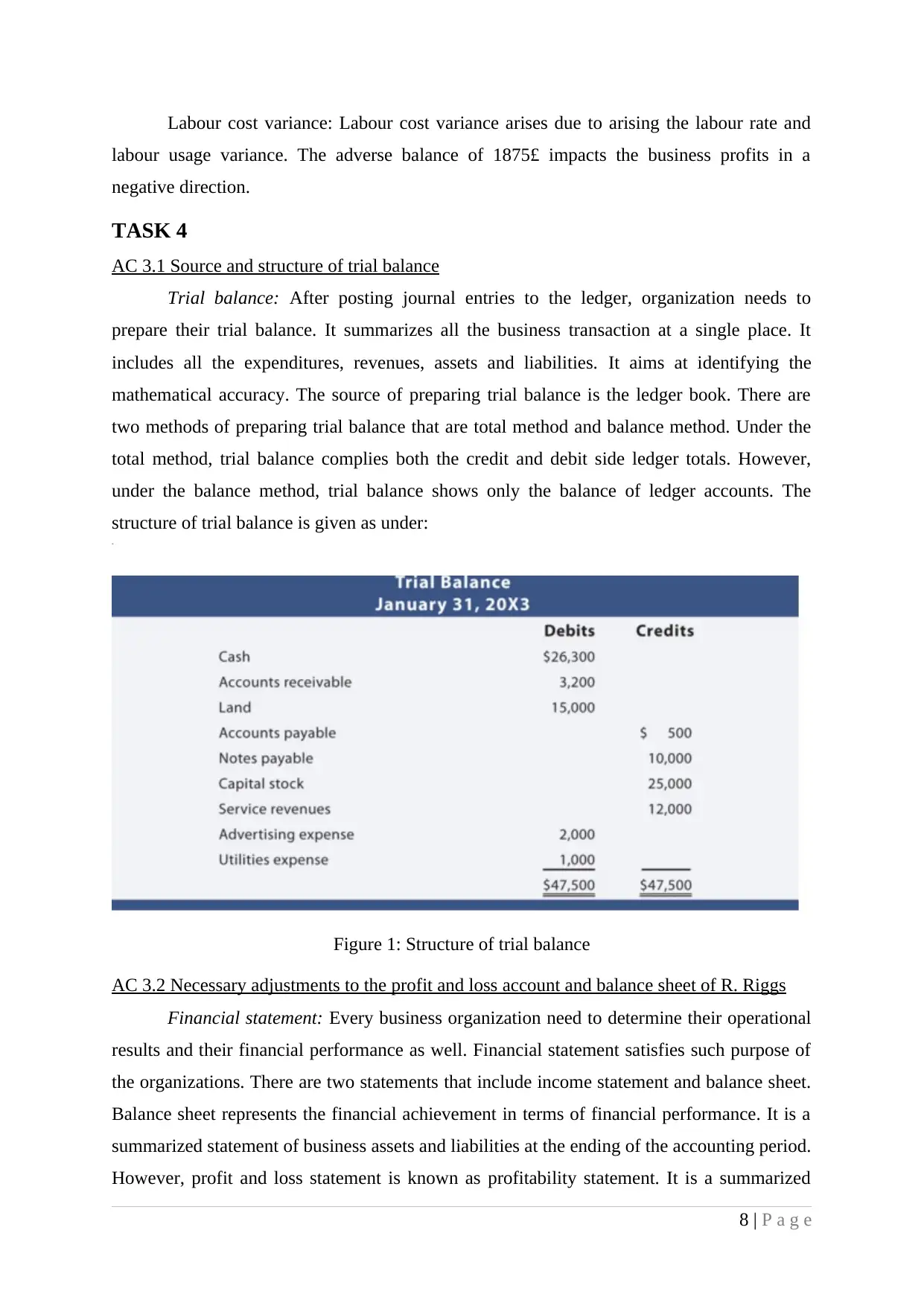
Labour cost variance: Labour cost variance arises due to arising the labour rate and
labour usage variance. The adverse balance of 1875£ impacts the business profits in a
negative direction.
TASK 4
AC 3.1 Source and structure of trial balance
Trial balance: After posting journal entries to the ledger, organization needs to
prepare their trial balance. It summarizes all the business transaction at a single place. It
includes all the expenditures, revenues, assets and liabilities. It aims at identifying the
mathematical accuracy. The source of preparing trial balance is the ledger book. There are
two methods of preparing trial balance that are total method and balance method. Under the
total method, trial balance complies both the credit and debit side ledger totals. However,
under the balance method, trial balance shows only the balance of ledger accounts. The
structure of trial balance is given as under:
Figure 1: Structure of trial balance
AC 3.2 Necessary adjustments to the profit and loss account and balance sheet of R. Riggs
Financial statement: Every business organization need to determine their operational
results and their financial performance as well. Financial statement satisfies such purpose of
the organizations. There are two statements that include income statement and balance sheet.
Balance sheet represents the financial achievement in terms of financial performance. It is a
summarized statement of business assets and liabilities at the ending of the accounting period.
However, profit and loss statement is known as profitability statement. It is a summarized
8 | P a g e
labour usage variance. The adverse balance of 1875£ impacts the business profits in a
negative direction.
TASK 4
AC 3.1 Source and structure of trial balance
Trial balance: After posting journal entries to the ledger, organization needs to
prepare their trial balance. It summarizes all the business transaction at a single place. It
includes all the expenditures, revenues, assets and liabilities. It aims at identifying the
mathematical accuracy. The source of preparing trial balance is the ledger book. There are
two methods of preparing trial balance that are total method and balance method. Under the
total method, trial balance complies both the credit and debit side ledger totals. However,
under the balance method, trial balance shows only the balance of ledger accounts. The
structure of trial balance is given as under:
Figure 1: Structure of trial balance
AC 3.2 Necessary adjustments to the profit and loss account and balance sheet of R. Riggs
Financial statement: Every business organization need to determine their operational
results and their financial performance as well. Financial statement satisfies such purpose of
the organizations. There are two statements that include income statement and balance sheet.
Balance sheet represents the financial achievement in terms of financial performance. It is a
summarized statement of business assets and liabilities at the ending of the accounting period.
However, profit and loss statement is known as profitability statement. It is a summarized
8 | P a g e
Secure Best Marks with AI Grader
Need help grading? Try our AI Grader for instant feedback on your assignments.
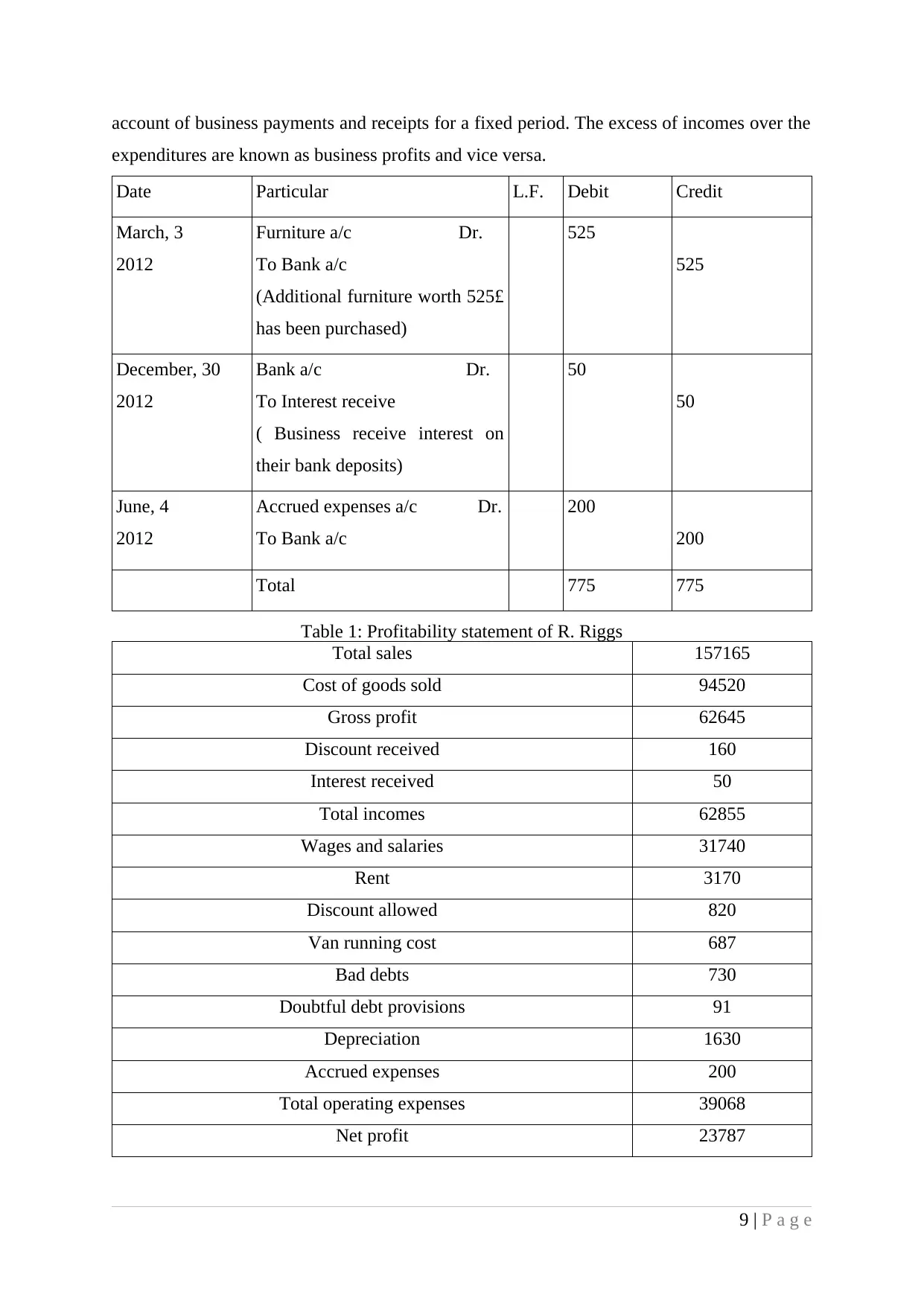
account of business payments and receipts for a fixed period. The excess of incomes over the
expenditures are known as business profits and vice versa.
Date Particular L.F. Debit Credit
March, 3
2012
Furniture a/c Dr.
To Bank a/c
(Additional furniture worth 525£
has been purchased)
525
525
December, 30
2012
Bank a/c Dr.
To Interest receive
( Business receive interest on
their bank deposits)
50
50
June, 4
2012
Accrued expenses a/c Dr.
To Bank a/c
200
200
Total 775 775
Table 1: Profitability statement of R. Riggs
Total sales 157165
Cost of goods sold 94520
Gross profit 62645
Discount received 160
Interest received 50
Total incomes 62855
Wages and salaries 31740
Rent 3170
Discount allowed 820
Van running cost 687
Bad debts 730
Doubtful debt provisions 91
Depreciation 1630
Accrued expenses 200
Total operating expenses 39068
Net profit 23787
9 | P a g e
expenditures are known as business profits and vice versa.
Date Particular L.F. Debit Credit
March, 3
2012
Furniture a/c Dr.
To Bank a/c
(Additional furniture worth 525£
has been purchased)
525
525
December, 30
2012
Bank a/c Dr.
To Interest receive
( Business receive interest on
their bank deposits)
50
50
June, 4
2012
Accrued expenses a/c Dr.
To Bank a/c
200
200
Total 775 775
Table 1: Profitability statement of R. Riggs
Total sales 157165
Cost of goods sold 94520
Gross profit 62645
Discount received 160
Interest received 50
Total incomes 62855
Wages and salaries 31740
Rent 3170
Discount allowed 820
Van running cost 687
Bad debts 730
Doubtful debt provisions 91
Depreciation 1630
Accrued expenses 200
Total operating expenses 39068
Net profit 23787
9 | P a g e
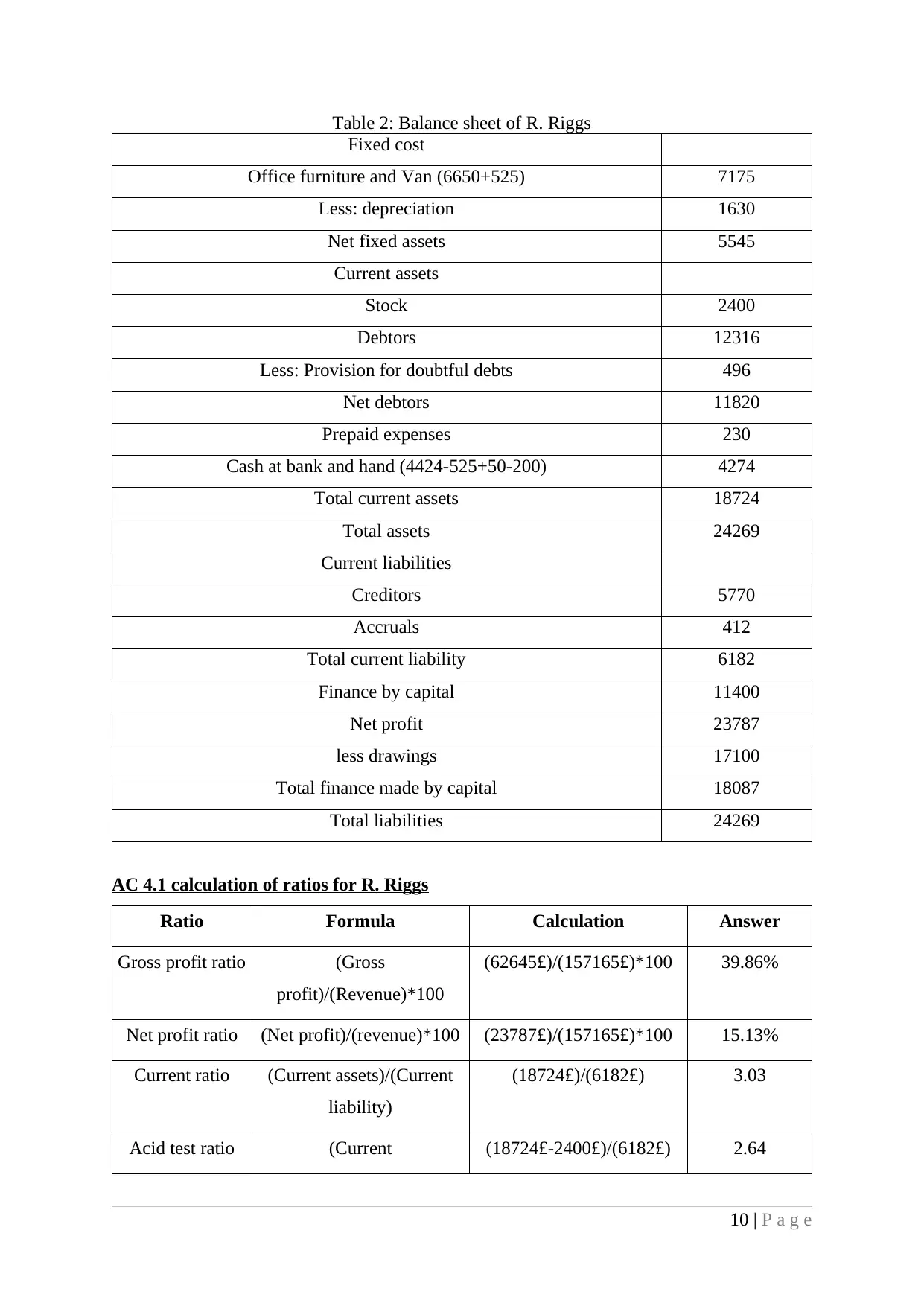
Table 2: Balance sheet of R. Riggs
Fixed cost
Office furniture and Van (6650+525) 7175
Less: depreciation 1630
Net fixed assets 5545
Current assets
Stock 2400
Debtors 12316
Less: Provision for doubtful debts 496
Net debtors 11820
Prepaid expenses 230
Cash at bank and hand (4424-525+50-200) 4274
Total current assets 18724
Total assets 24269
Current liabilities
Creditors 5770
Accruals 412
Total current liability 6182
Finance by capital 11400
Net profit 23787
less drawings 17100
Total finance made by capital 18087
Total liabilities 24269
AC 4.1 calculation of ratios for R. Riggs
Ratio Formula Calculation Answer
Gross profit ratio (Gross
profit)/(Revenue)*100
(62645£)/(157165£)*100 39.86%
Net profit ratio (Net profit)/(revenue)*100 (23787£)/(157165£)*100 15.13%
Current ratio (Current assets)/(Current
liability)
(18724£)/(6182£) 3.03
Acid test ratio (Current (18724£-2400£)/(6182£) 2.64
10 | P a g e
Fixed cost
Office furniture and Van (6650+525) 7175
Less: depreciation 1630
Net fixed assets 5545
Current assets
Stock 2400
Debtors 12316
Less: Provision for doubtful debts 496
Net debtors 11820
Prepaid expenses 230
Cash at bank and hand (4424-525+50-200) 4274
Total current assets 18724
Total assets 24269
Current liabilities
Creditors 5770
Accruals 412
Total current liability 6182
Finance by capital 11400
Net profit 23787
less drawings 17100
Total finance made by capital 18087
Total liabilities 24269
AC 4.1 calculation of ratios for R. Riggs
Ratio Formula Calculation Answer
Gross profit ratio (Gross
profit)/(Revenue)*100
(62645£)/(157165£)*100 39.86%
Net profit ratio (Net profit)/(revenue)*100 (23787£)/(157165£)*100 15.13%
Current ratio (Current assets)/(Current
liability)
(18724£)/(6182£) 3.03
Acid test ratio (Current (18724£-2400£)/(6182£) 2.64
10 | P a g e
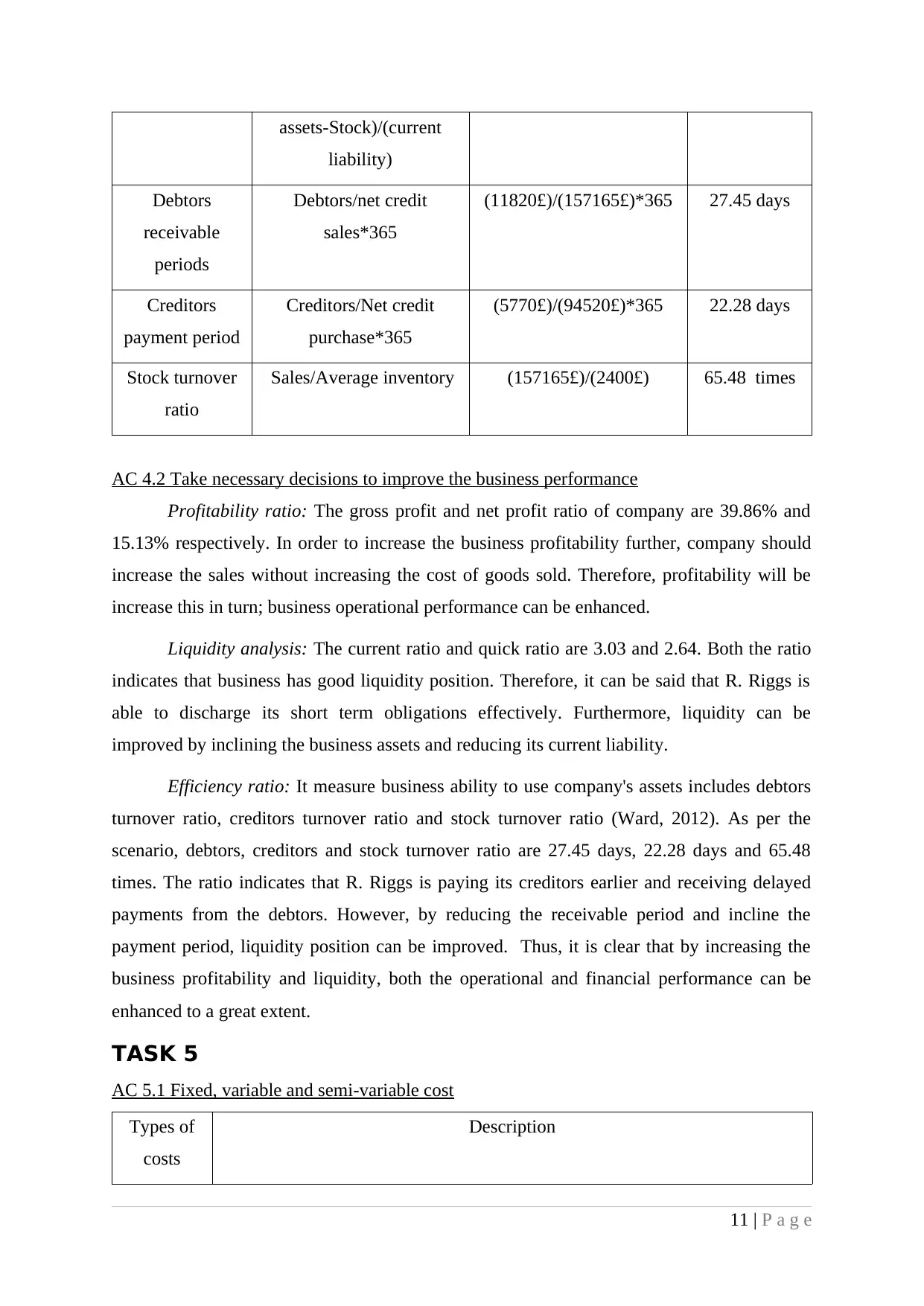
assets-Stock)/(current
liability)
Debtors
receivable
periods
Debtors/net credit
sales*365
(11820£)/(157165£)*365 27.45 days
Creditors
payment period
Creditors/Net credit
purchase*365
(5770£)/(94520£)*365 22.28 days
Stock turnover
ratio
Sales/Average inventory (157165£)/(2400£) 65.48 times
AC 4.2 Take necessary decisions to improve the business performance
Profitability ratio: The gross profit and net profit ratio of company are 39.86% and
15.13% respectively. In order to increase the business profitability further, company should
increase the sales without increasing the cost of goods sold. Therefore, profitability will be
increase this in turn; business operational performance can be enhanced.
Liquidity analysis: The current ratio and quick ratio are 3.03 and 2.64. Both the ratio
indicates that business has good liquidity position. Therefore, it can be said that R. Riggs is
able to discharge its short term obligations effectively. Furthermore, liquidity can be
improved by inclining the business assets and reducing its current liability.
Efficiency ratio: It measure business ability to use company's assets includes debtors
turnover ratio, creditors turnover ratio and stock turnover ratio (Ward, 2012). As per the
scenario, debtors, creditors and stock turnover ratio are 27.45 days, 22.28 days and 65.48
times. The ratio indicates that R. Riggs is paying its creditors earlier and receiving delayed
payments from the debtors. However, by reducing the receivable period and incline the
payment period, liquidity position can be improved. Thus, it is clear that by increasing the
business profitability and liquidity, both the operational and financial performance can be
enhanced to a great extent.
TASK 5
AC 5.1 Fixed, variable and semi-variable cost
Types of
costs
Description
11 | P a g e
liability)
Debtors
receivable
periods
Debtors/net credit
sales*365
(11820£)/(157165£)*365 27.45 days
Creditors
payment period
Creditors/Net credit
purchase*365
(5770£)/(94520£)*365 22.28 days
Stock turnover
ratio
Sales/Average inventory (157165£)/(2400£) 65.48 times
AC 4.2 Take necessary decisions to improve the business performance
Profitability ratio: The gross profit and net profit ratio of company are 39.86% and
15.13% respectively. In order to increase the business profitability further, company should
increase the sales without increasing the cost of goods sold. Therefore, profitability will be
increase this in turn; business operational performance can be enhanced.
Liquidity analysis: The current ratio and quick ratio are 3.03 and 2.64. Both the ratio
indicates that business has good liquidity position. Therefore, it can be said that R. Riggs is
able to discharge its short term obligations effectively. Furthermore, liquidity can be
improved by inclining the business assets and reducing its current liability.
Efficiency ratio: It measure business ability to use company's assets includes debtors
turnover ratio, creditors turnover ratio and stock turnover ratio (Ward, 2012). As per the
scenario, debtors, creditors and stock turnover ratio are 27.45 days, 22.28 days and 65.48
times. The ratio indicates that R. Riggs is paying its creditors earlier and receiving delayed
payments from the debtors. However, by reducing the receivable period and incline the
payment period, liquidity position can be improved. Thus, it is clear that by increasing the
business profitability and liquidity, both the operational and financial performance can be
enhanced to a great extent.
TASK 5
AC 5.1 Fixed, variable and semi-variable cost
Types of
costs
Description
11 | P a g e
Paraphrase This Document
Need a fresh take? Get an instant paraphrase of this document with our AI Paraphraser
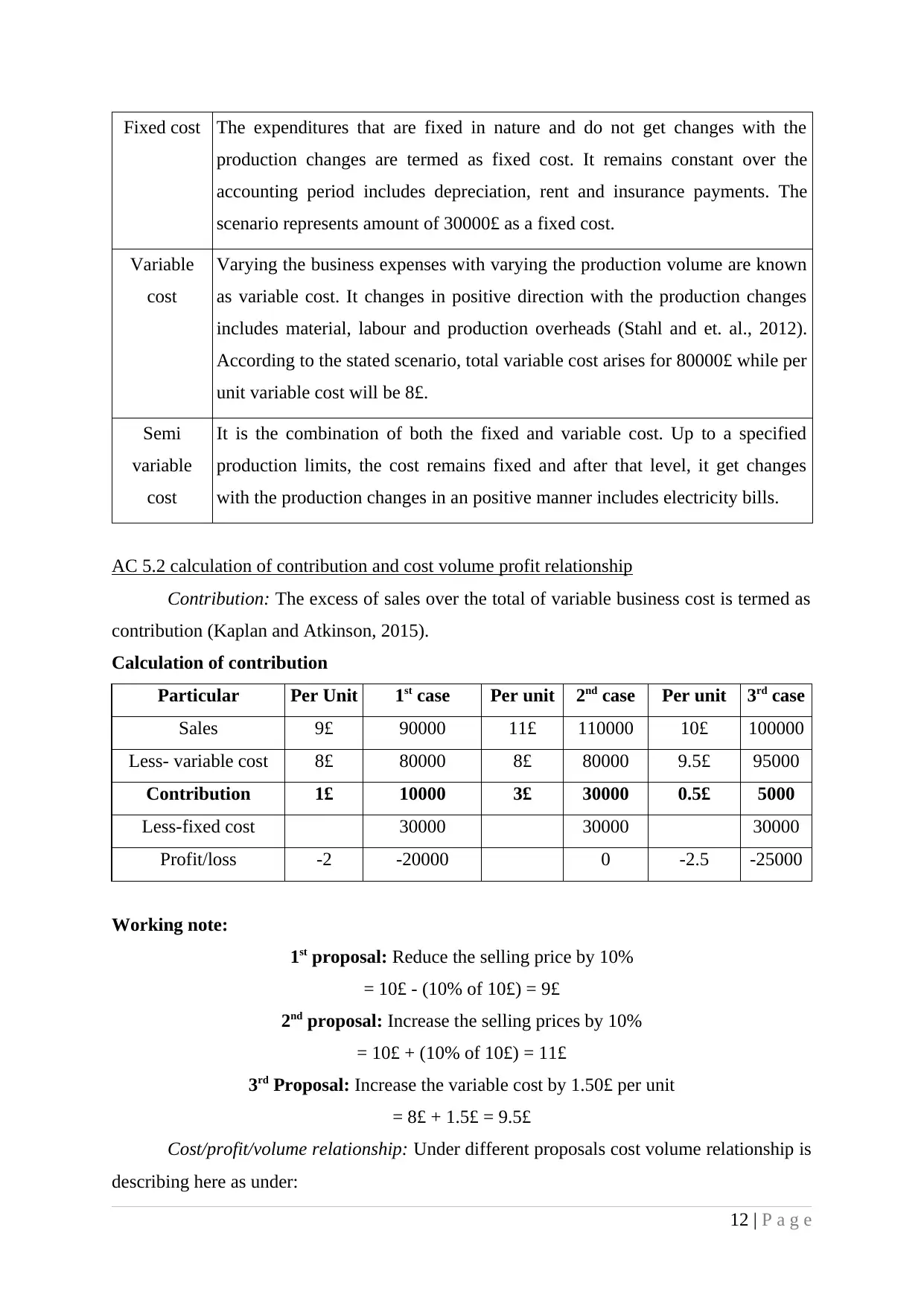
Fixed cost The expenditures that are fixed in nature and do not get changes with the
production changes are termed as fixed cost. It remains constant over the
accounting period includes depreciation, rent and insurance payments. The
scenario represents amount of 30000£ as a fixed cost.
Variable
cost
Varying the business expenses with varying the production volume are known
as variable cost. It changes in positive direction with the production changes
includes material, labour and production overheads (Stahl and et. al., 2012).
According to the stated scenario, total variable cost arises for 80000£ while per
unit variable cost will be 8£.
Semi
variable
cost
It is the combination of both the fixed and variable cost. Up to a specified
production limits, the cost remains fixed and after that level, it get changes
with the production changes in an positive manner includes electricity bills.
AC 5.2 calculation of contribution and cost volume profit relationship
Contribution: The excess of sales over the total of variable business cost is termed as
contribution (Kaplan and Atkinson, 2015).
Calculation of contribution
Particular Per Unit 1st case Per unit 2nd case Per unit 3rd case
Sales 9£ 90000 11£ 110000 10£ 100000
Less- variable cost 8£ 80000 8£ 80000 9.5£ 95000
Contribution 1£ 10000 3£ 30000 0.5£ 5000
Less-fixed cost 30000 30000 30000
Profit/loss -2 -20000 0 -2.5 -25000
Working note:
1st proposal: Reduce the selling price by 10%
= 10£ - (10% of 10£) = 9£
2nd proposal: Increase the selling prices by 10%
= 10£ + (10% of 10£) = 11£
3rd Proposal: Increase the variable cost by 1.50£ per unit
= 8£ + 1.5£ = 9.5£
Cost/profit/volume relationship: Under different proposals cost volume relationship is
describing here as under:
12 | P a g e
production changes are termed as fixed cost. It remains constant over the
accounting period includes depreciation, rent and insurance payments. The
scenario represents amount of 30000£ as a fixed cost.
Variable
cost
Varying the business expenses with varying the production volume are known
as variable cost. It changes in positive direction with the production changes
includes material, labour and production overheads (Stahl and et. al., 2012).
According to the stated scenario, total variable cost arises for 80000£ while per
unit variable cost will be 8£.
Semi
variable
cost
It is the combination of both the fixed and variable cost. Up to a specified
production limits, the cost remains fixed and after that level, it get changes
with the production changes in an positive manner includes electricity bills.
AC 5.2 calculation of contribution and cost volume profit relationship
Contribution: The excess of sales over the total of variable business cost is termed as
contribution (Kaplan and Atkinson, 2015).
Calculation of contribution
Particular Per Unit 1st case Per unit 2nd case Per unit 3rd case
Sales 9£ 90000 11£ 110000 10£ 100000
Less- variable cost 8£ 80000 8£ 80000 9.5£ 95000
Contribution 1£ 10000 3£ 30000 0.5£ 5000
Less-fixed cost 30000 30000 30000
Profit/loss -2 -20000 0 -2.5 -25000
Working note:
1st proposal: Reduce the selling price by 10%
= 10£ - (10% of 10£) = 9£
2nd proposal: Increase the selling prices by 10%
= 10£ + (10% of 10£) = 11£
3rd Proposal: Increase the variable cost by 1.50£ per unit
= 8£ + 1.5£ = 9.5£
Cost/profit/volume relationship: Under different proposals cost volume relationship is
describing here as under:
12 | P a g e
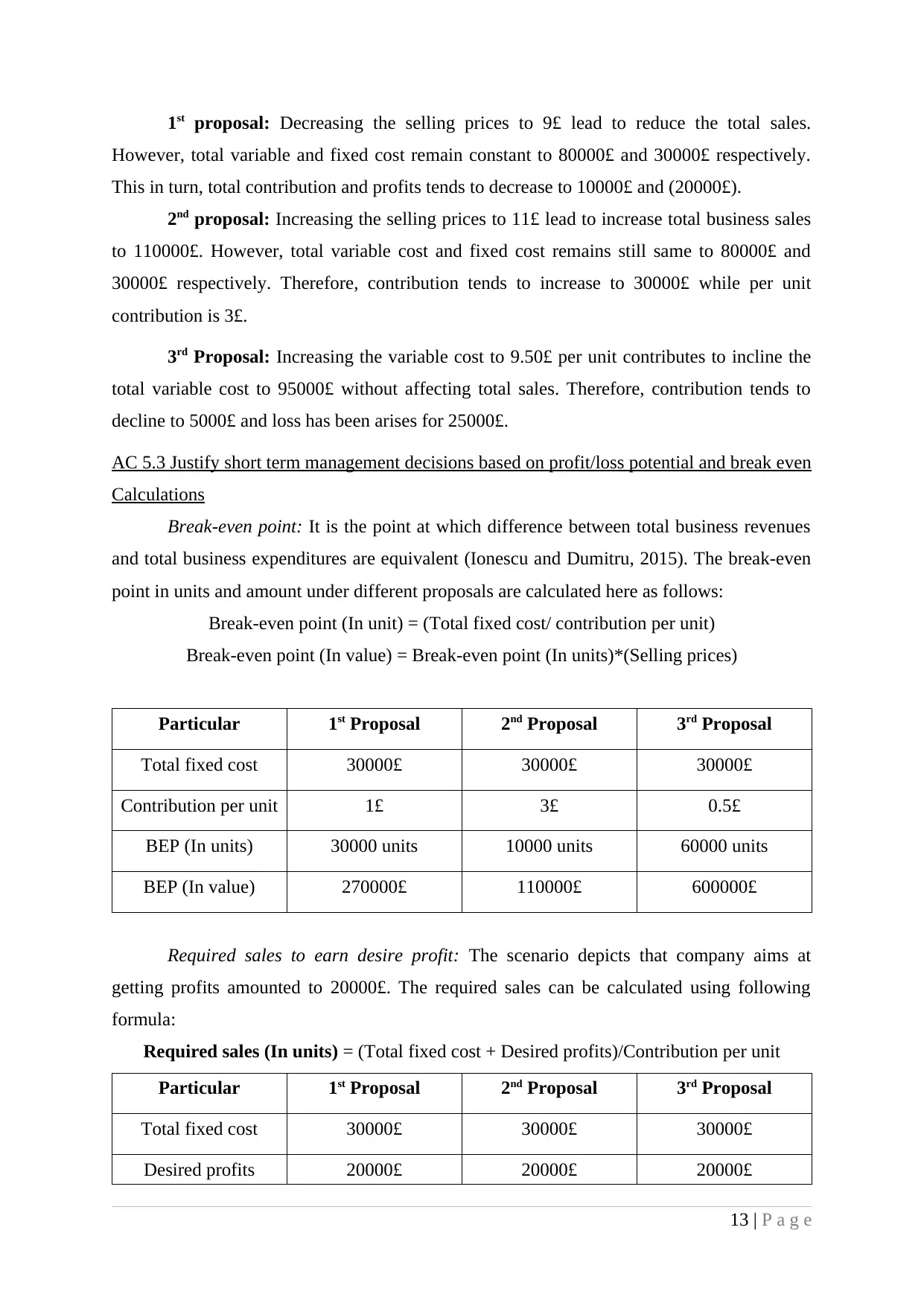
1st proposal: Decreasing the selling prices to 9£ lead to reduce the total sales.
However, total variable and fixed cost remain constant to 80000£ and 30000£ respectively.
This in turn, total contribution and profits tends to decrease to 10000£ and (20000£).
2nd proposal: Increasing the selling prices to 11£ lead to increase total business sales
to 110000£. However, total variable cost and fixed cost remains still same to 80000£ and
30000£ respectively. Therefore, contribution tends to increase to 30000£ while per unit
contribution is 3£.
3rd Proposal: Increasing the variable cost to 9.50£ per unit contributes to incline the
total variable cost to 95000£ without affecting total sales. Therefore, contribution tends to
decline to 5000£ and loss has been arises for 25000£.
AC 5.3 Justify short term management decisions based on profit/loss potential and break even
Calculations
Break-even point: It is the point at which difference between total business revenues
and total business expenditures are equivalent (Ionescu and Dumitru, 2015). The break-even
point in units and amount under different proposals are calculated here as follows:
Break-even point (In unit) = (Total fixed cost/ contribution per unit)
Break-even point (In value) = Break-even point (In units)*(Selling prices)
Particular 1st Proposal 2nd Proposal 3rd Proposal
Total fixed cost 30000£ 30000£ 30000£
Contribution per unit 1£ 3£ 0.5£
BEP (In units) 30000 units 10000 units 60000 units
BEP (In value) 270000£ 110000£ 600000£
Required sales to earn desire profit: The scenario depicts that company aims at
getting profits amounted to 20000£. The required sales can be calculated using following
formula:
Required sales (In units) = (Total fixed cost + Desired profits)/Contribution per unit
Particular 1st Proposal 2nd Proposal 3rd Proposal
Total fixed cost 30000£ 30000£ 30000£
Desired profits 20000£ 20000£ 20000£
13 | P a g e
However, total variable and fixed cost remain constant to 80000£ and 30000£ respectively.
This in turn, total contribution and profits tends to decrease to 10000£ and (20000£).
2nd proposal: Increasing the selling prices to 11£ lead to increase total business sales
to 110000£. However, total variable cost and fixed cost remains still same to 80000£ and
30000£ respectively. Therefore, contribution tends to increase to 30000£ while per unit
contribution is 3£.
3rd Proposal: Increasing the variable cost to 9.50£ per unit contributes to incline the
total variable cost to 95000£ without affecting total sales. Therefore, contribution tends to
decline to 5000£ and loss has been arises for 25000£.
AC 5.3 Justify short term management decisions based on profit/loss potential and break even
Calculations
Break-even point: It is the point at which difference between total business revenues
and total business expenditures are equivalent (Ionescu and Dumitru, 2015). The break-even
point in units and amount under different proposals are calculated here as follows:
Break-even point (In unit) = (Total fixed cost/ contribution per unit)
Break-even point (In value) = Break-even point (In units)*(Selling prices)
Particular 1st Proposal 2nd Proposal 3rd Proposal
Total fixed cost 30000£ 30000£ 30000£
Contribution per unit 1£ 3£ 0.5£
BEP (In units) 30000 units 10000 units 60000 units
BEP (In value) 270000£ 110000£ 600000£
Required sales to earn desire profit: The scenario depicts that company aims at
getting profits amounted to 20000£. The required sales can be calculated using following
formula:
Required sales (In units) = (Total fixed cost + Desired profits)/Contribution per unit
Particular 1st Proposal 2nd Proposal 3rd Proposal
Total fixed cost 30000£ 30000£ 30000£
Desired profits 20000£ 20000£ 20000£
13 | P a g e
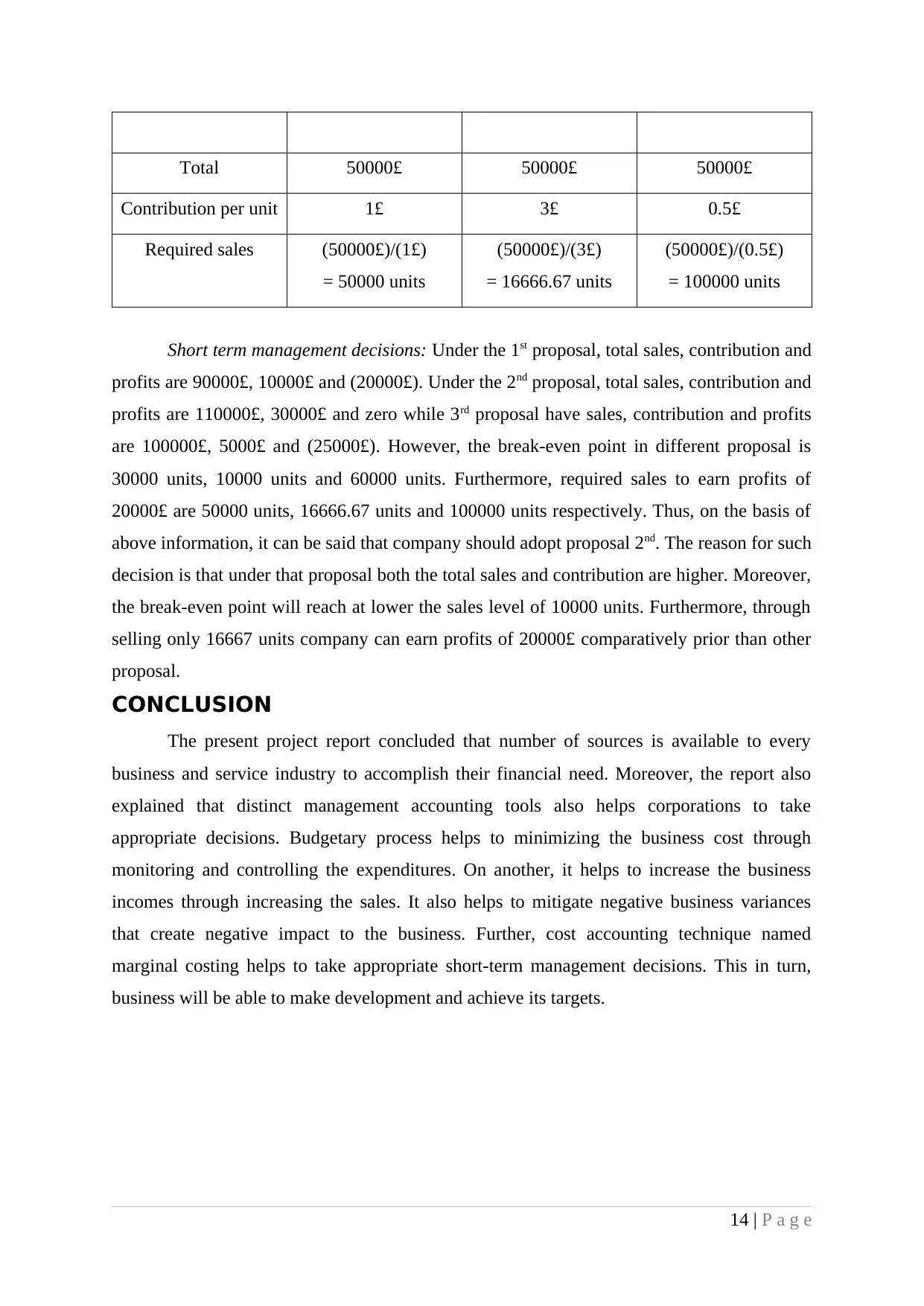
Total 50000£ 50000£ 50000£
Contribution per unit 1£ 3£ 0.5£
Required sales (50000£)/(1£)
= 50000 units
(50000£)/(3£)
= 16666.67 units
(50000£)/(0.5£)
= 100000 units
Short term management decisions: Under the 1st proposal, total sales, contribution and
profits are 90000£, 10000£ and (20000£). Under the 2nd proposal, total sales, contribution and
profits are 110000£, 30000£ and zero while 3rd proposal have sales, contribution and profits
are 100000£, 5000£ and (25000£). However, the break-even point in different proposal is
30000 units, 10000 units and 60000 units. Furthermore, required sales to earn profits of
20000£ are 50000 units, 16666.67 units and 100000 units respectively. Thus, on the basis of
above information, it can be said that company should adopt proposal 2nd. The reason for such
decision is that under that proposal both the total sales and contribution are higher. Moreover,
the break-even point will reach at lower the sales level of 10000 units. Furthermore, through
selling only 16667 units company can earn profits of 20000£ comparatively prior than other
proposal.
CONCLUSION
The present project report concluded that number of sources is available to every
business and service industry to accomplish their financial need. Moreover, the report also
explained that distinct management accounting tools also helps corporations to take
appropriate decisions. Budgetary process helps to minimizing the business cost through
monitoring and controlling the expenditures. On another, it helps to increase the business
incomes through increasing the sales. It also helps to mitigate negative business variances
that create negative impact to the business. Further, cost accounting technique named
marginal costing helps to take appropriate short-term management decisions. This in turn,
business will be able to make development and achieve its targets.
14 | P a g e
Contribution per unit 1£ 3£ 0.5£
Required sales (50000£)/(1£)
= 50000 units
(50000£)/(3£)
= 16666.67 units
(50000£)/(0.5£)
= 100000 units
Short term management decisions: Under the 1st proposal, total sales, contribution and
profits are 90000£, 10000£ and (20000£). Under the 2nd proposal, total sales, contribution and
profits are 110000£, 30000£ and zero while 3rd proposal have sales, contribution and profits
are 100000£, 5000£ and (25000£). However, the break-even point in different proposal is
30000 units, 10000 units and 60000 units. Furthermore, required sales to earn profits of
20000£ are 50000 units, 16666.67 units and 100000 units respectively. Thus, on the basis of
above information, it can be said that company should adopt proposal 2nd. The reason for such
decision is that under that proposal both the total sales and contribution are higher. Moreover,
the break-even point will reach at lower the sales level of 10000 units. Furthermore, through
selling only 16667 units company can earn profits of 20000£ comparatively prior than other
proposal.
CONCLUSION
The present project report concluded that number of sources is available to every
business and service industry to accomplish their financial need. Moreover, the report also
explained that distinct management accounting tools also helps corporations to take
appropriate decisions. Budgetary process helps to minimizing the business cost through
monitoring and controlling the expenditures. On another, it helps to increase the business
incomes through increasing the sales. It also helps to mitigate negative business variances
that create negative impact to the business. Further, cost accounting technique named
marginal costing helps to take appropriate short-term management decisions. This in turn,
business will be able to make development and achieve its targets.
14 | P a g e
Secure Best Marks with AI Grader
Need help grading? Try our AI Grader for instant feedback on your assignments.
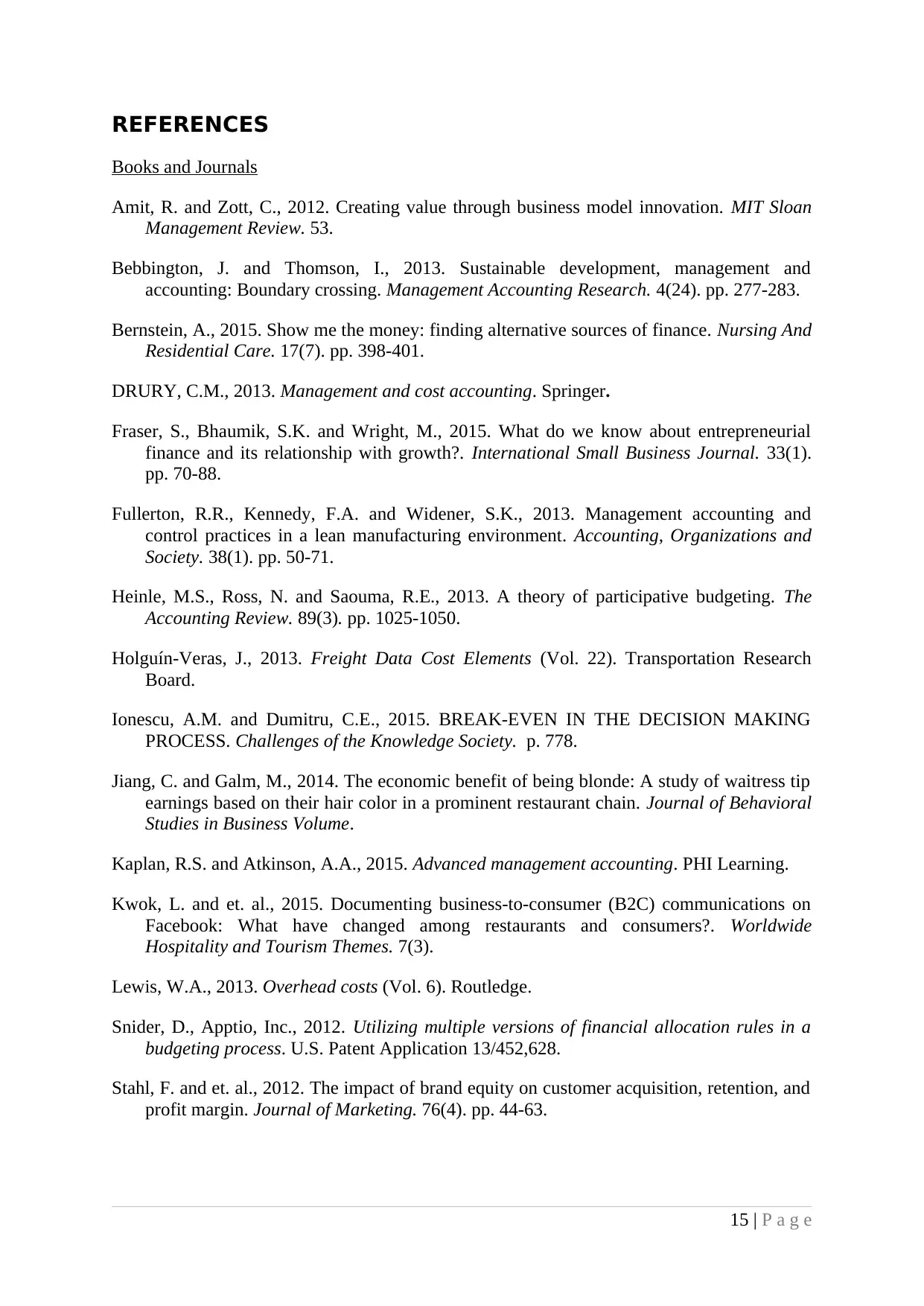
REFERENCES
Books and Journals
Amit, R. and Zott, C., 2012. Creating value through business model innovation. MIT Sloan
Management Review. 53.
Bebbington, J. and Thomson, I., 2013. Sustainable development, management and
accounting: Boundary crossing. Management Accounting Research. 4(24). pp. 277-283.
Bernstein, A., 2015. Show me the money: finding alternative sources of finance. Nursing And
Residential Care. 17(7). pp. 398-401.
DRURY, C.M., 2013. Management and cost accounting. Springer.
Fraser, S., Bhaumik, S.K. and Wright, M., 2015. What do we know about entrepreneurial
finance and its relationship with growth?. International Small Business Journal. 33(1).
pp. 70-88.
Fullerton, R.R., Kennedy, F.A. and Widener, S.K., 2013. Management accounting and
control practices in a lean manufacturing environment. Accounting, Organizations and
Society. 38(1). pp. 50-71.
Heinle, M.S., Ross, N. and Saouma, R.E., 2013. A theory of participative budgeting. The
Accounting Review. 89(3). pp. 1025-1050.
Holguín-Veras, J., 2013. Freight Data Cost Elements (Vol. 22). Transportation Research
Board.
Ionescu, A.M. and Dumitru, C.E., 2015. BREAK-EVEN IN THE DECISION MAKING
PROCESS. Challenges of the Knowledge Society. p. 778.
Jiang, C. and Galm, M., 2014. The economic benefit of being blonde: A study of waitress tip
earnings based on their hair color in a prominent restaurant chain. Journal of Behavioral
Studies in Business Volume.
Kaplan, R.S. and Atkinson, A.A., 2015. Advanced management accounting. PHI Learning.
Kwok, L. and et. al., 2015. Documenting business-to-consumer (B2C) communications on
Facebook: What have changed among restaurants and consumers?. Worldwide
Hospitality and Tourism Themes. 7(3).
Lewis, W.A., 2013. Overhead costs (Vol. 6). Routledge.
Snider, D., Apptio, Inc., 2012. Utilizing multiple versions of financial allocation rules in a
budgeting process. U.S. Patent Application 13/452,628.
Stahl, F. and et. al., 2012. The impact of brand equity on customer acquisition, retention, and
profit margin. Journal of Marketing. 76(4). pp. 44-63.
15 | P a g e
Books and Journals
Amit, R. and Zott, C., 2012. Creating value through business model innovation. MIT Sloan
Management Review. 53.
Bebbington, J. and Thomson, I., 2013. Sustainable development, management and
accounting: Boundary crossing. Management Accounting Research. 4(24). pp. 277-283.
Bernstein, A., 2015. Show me the money: finding alternative sources of finance. Nursing And
Residential Care. 17(7). pp. 398-401.
DRURY, C.M., 2013. Management and cost accounting. Springer.
Fraser, S., Bhaumik, S.K. and Wright, M., 2015. What do we know about entrepreneurial
finance and its relationship with growth?. International Small Business Journal. 33(1).
pp. 70-88.
Fullerton, R.R., Kennedy, F.A. and Widener, S.K., 2013. Management accounting and
control practices in a lean manufacturing environment. Accounting, Organizations and
Society. 38(1). pp. 50-71.
Heinle, M.S., Ross, N. and Saouma, R.E., 2013. A theory of participative budgeting. The
Accounting Review. 89(3). pp. 1025-1050.
Holguín-Veras, J., 2013. Freight Data Cost Elements (Vol. 22). Transportation Research
Board.
Ionescu, A.M. and Dumitru, C.E., 2015. BREAK-EVEN IN THE DECISION MAKING
PROCESS. Challenges of the Knowledge Society. p. 778.
Jiang, C. and Galm, M., 2014. The economic benefit of being blonde: A study of waitress tip
earnings based on their hair color in a prominent restaurant chain. Journal of Behavioral
Studies in Business Volume.
Kaplan, R.S. and Atkinson, A.A., 2015. Advanced management accounting. PHI Learning.
Kwok, L. and et. al., 2015. Documenting business-to-consumer (B2C) communications on
Facebook: What have changed among restaurants and consumers?. Worldwide
Hospitality and Tourism Themes. 7(3).
Lewis, W.A., 2013. Overhead costs (Vol. 6). Routledge.
Snider, D., Apptio, Inc., 2012. Utilizing multiple versions of financial allocation rules in a
budgeting process. U.S. Patent Application 13/452,628.
Stahl, F. and et. al., 2012. The impact of brand equity on customer acquisition, retention, and
profit margin. Journal of Marketing. 76(4). pp. 44-63.
15 | P a g e
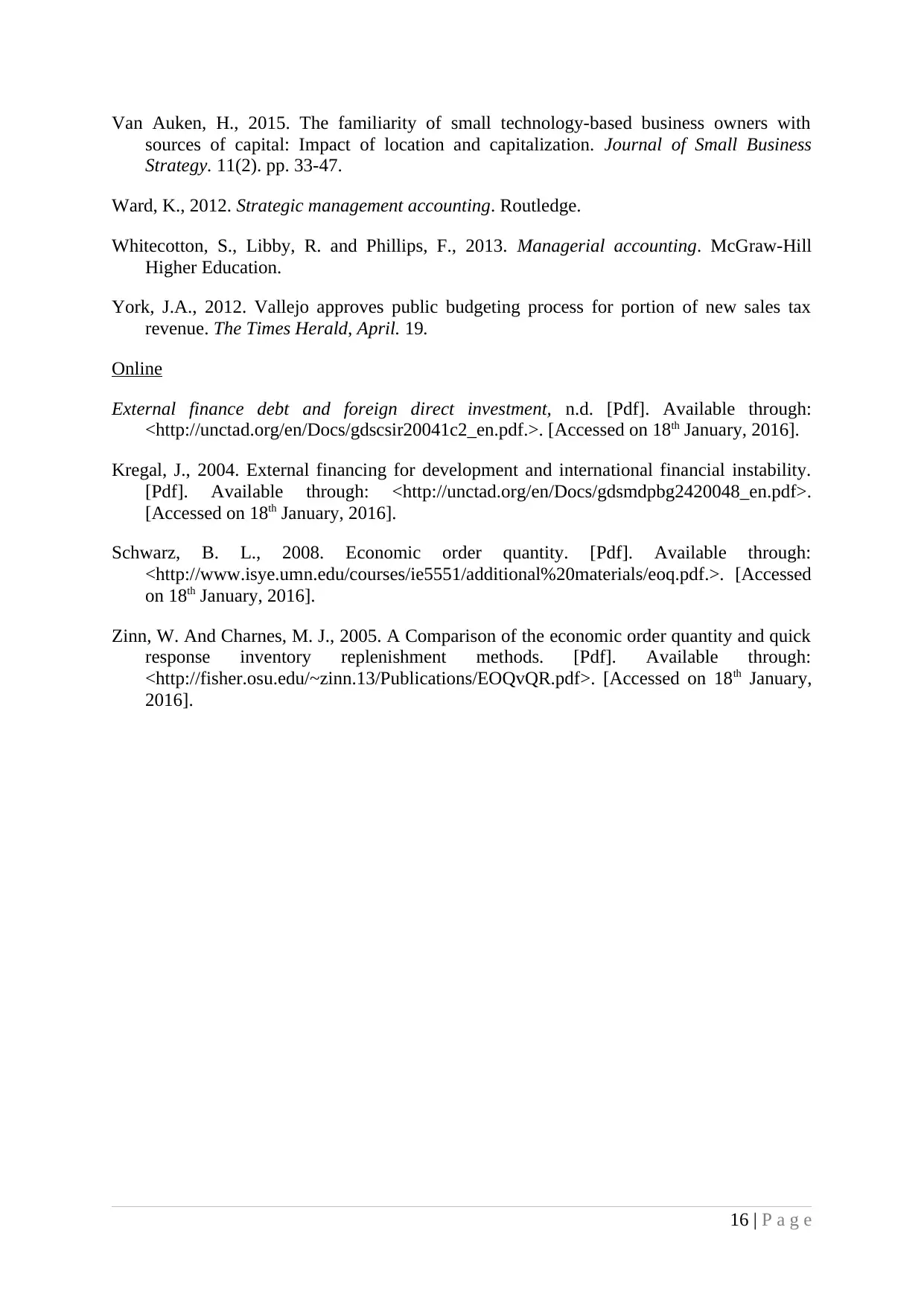
Van Auken, H., 2015. The familiarity of small technology-based business owners with
sources of capital: Impact of location and capitalization. Journal of Small Business
Strategy. 11(2). pp. 33-47.
Ward, K., 2012. Strategic management accounting. Routledge.
Whitecotton, S., Libby, R. and Phillips, F., 2013. Managerial accounting. McGraw-Hill
Higher Education.
York, J.A., 2012. Vallejo approves public budgeting process for portion of new sales tax
revenue. The Times Herald, April. 19.
Online
External finance debt and foreign direct investment, n.d. [Pdf]. Available through:
<http://unctad.org/en/Docs/gdscsir20041c2_en.pdf.>. [Accessed on 18th January, 2016].
Kregal, J., 2004. External financing for development and international financial instability.
[Pdf]. Available through: <http://unctad.org/en/Docs/gdsmdpbg2420048_en.pdf>.
[Accessed on 18th January, 2016].
Schwarz, B. L., 2008. Economic order quantity. [Pdf]. Available through:
<http://www.isye.umn.edu/courses/ie5551/additional%20materials/eoq.pdf.>. [Accessed
on 18th January, 2016].
Zinn, W. And Charnes, M. J., 2005. A Comparison of the economic order quantity and quick
response inventory replenishment methods. [Pdf]. Available through:
<http://fisher.osu.edu/~zinn.13/Publications/EOQvQR.pdf>. [Accessed on 18th January,
2016].
16 | P a g e
sources of capital: Impact of location and capitalization. Journal of Small Business
Strategy. 11(2). pp. 33-47.
Ward, K., 2012. Strategic management accounting. Routledge.
Whitecotton, S., Libby, R. and Phillips, F., 2013. Managerial accounting. McGraw-Hill
Higher Education.
York, J.A., 2012. Vallejo approves public budgeting process for portion of new sales tax
revenue. The Times Herald, April. 19.
Online
External finance debt and foreign direct investment, n.d. [Pdf]. Available through:
<http://unctad.org/en/Docs/gdscsir20041c2_en.pdf.>. [Accessed on 18th January, 2016].
Kregal, J., 2004. External financing for development and international financial instability.
[Pdf]. Available through: <http://unctad.org/en/Docs/gdsmdpbg2420048_en.pdf>.
[Accessed on 18th January, 2016].
Schwarz, B. L., 2008. Economic order quantity. [Pdf]. Available through:
<http://www.isye.umn.edu/courses/ie5551/additional%20materials/eoq.pdf.>. [Accessed
on 18th January, 2016].
Zinn, W. And Charnes, M. J., 2005. A Comparison of the economic order quantity and quick
response inventory replenishment methods. [Pdf]. Available through:
<http://fisher.osu.edu/~zinn.13/Publications/EOQvQR.pdf>. [Accessed on 18th January,
2016].
16 | P a g e
1 out of 18
Related Documents
Your All-in-One AI-Powered Toolkit for Academic Success.
+13062052269
info@desklib.com
Available 24*7 on WhatsApp / Email
![[object Object]](/_next/static/media/star-bottom.7253800d.svg)
Unlock your academic potential
© 2024 | Zucol Services PVT LTD | All rights reserved.




![[PDF] Finance in Hospitality Industry Assignment](/_next/image/?url=https%3A%2F%2Fdesklib.com%2Fmedia%2Fimages%2Fip%2F7544c281d3f248e59902328f766a57f7.jpg&w=256&q=75)
